Abstract
In the first part of this paper we have indicated how the techniques and capabilities of theoretical chemistry, together with experimental results, can be used in a mechanistic approach to structure-activity studies of toxicity. In the second part, we have illustrated how this computer-assisted approach has been used to identify and calculate causally related molecular indicators of relative carcinogenic activity in five classes of chemical carcinogens: polycyclic aromatic hydrocarbons and their methyl derivatives, aromatic amines, chloroethanes, chloroalkenes and dialkyl nitrosamines. In each class of chemicals studied, candidate molecular indicators have been identified that could be useful in predictive screening of unknown compounds. In addition, further insights into some mechanistic aspects of chemical carcinogenesis have been obtained. Finally, experiments have been suggested to both verify the usefulness of the indicators and test their mechanistic implications.
Full text
PDF
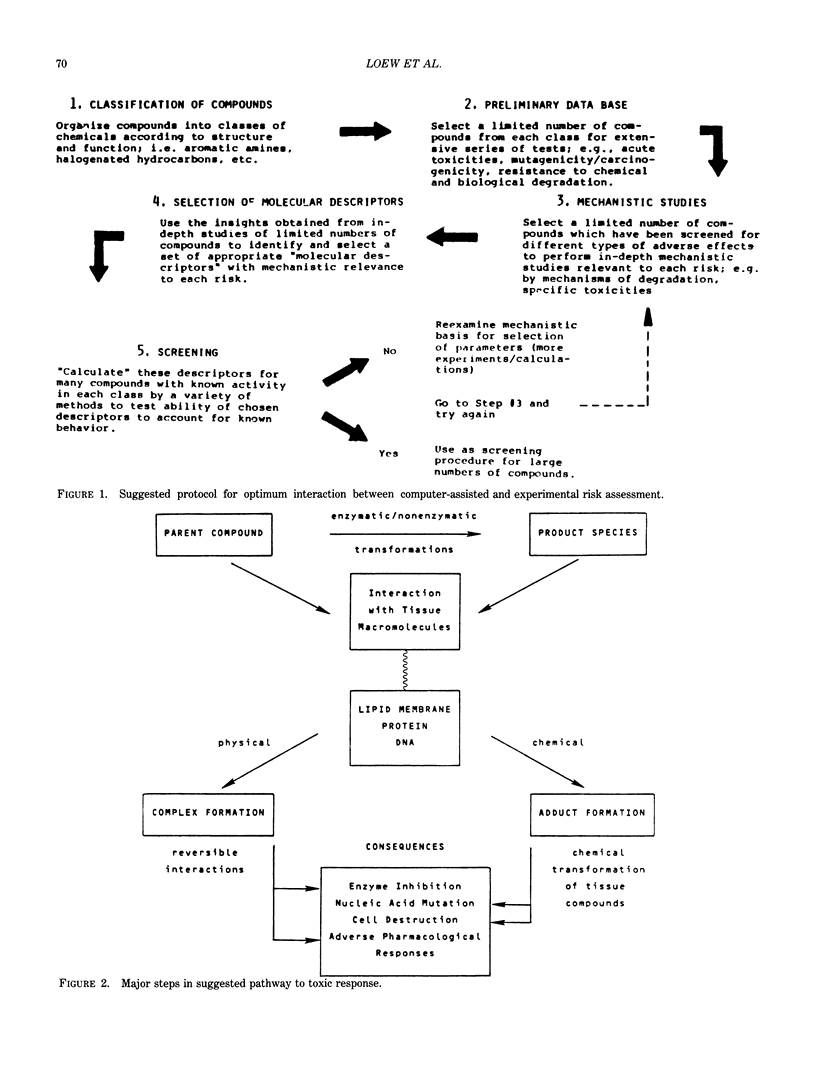
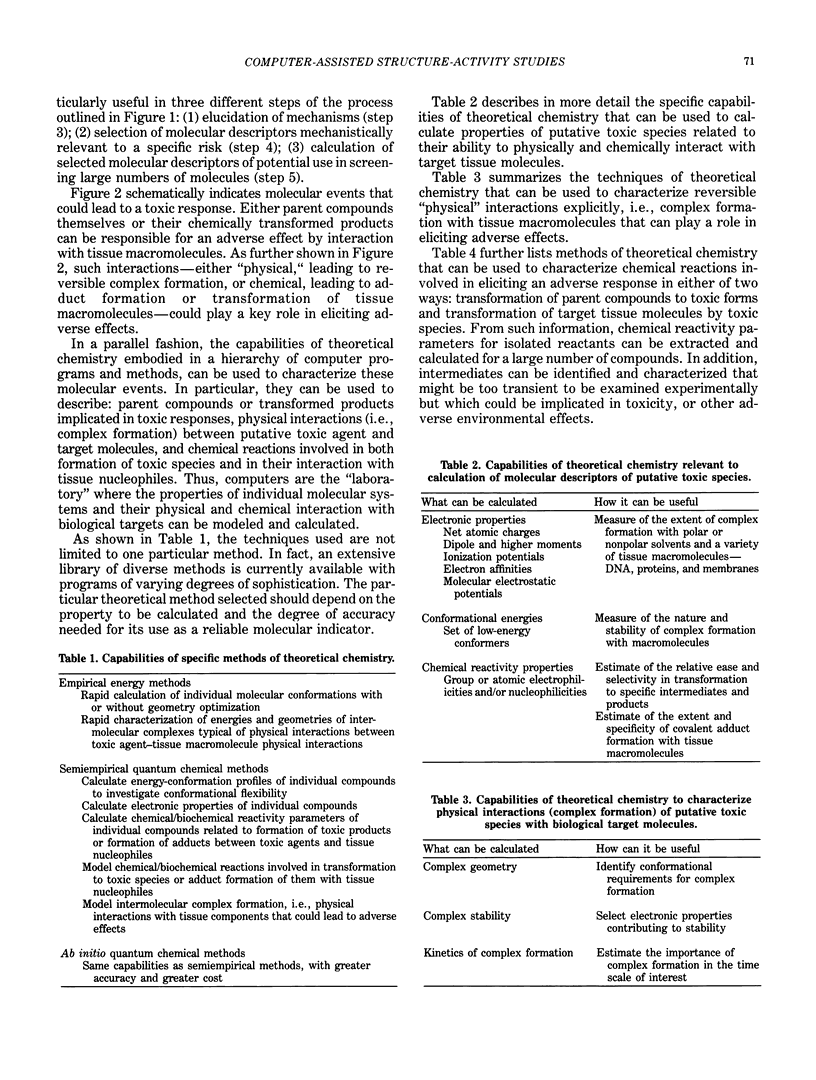
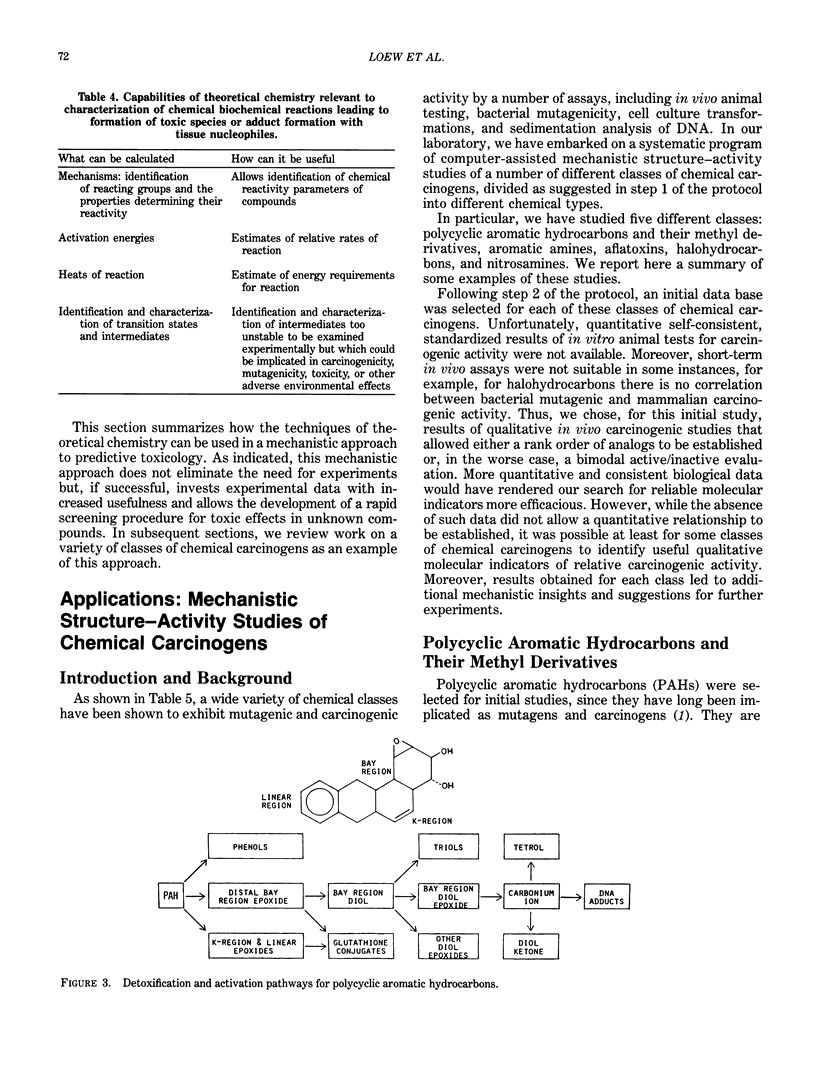
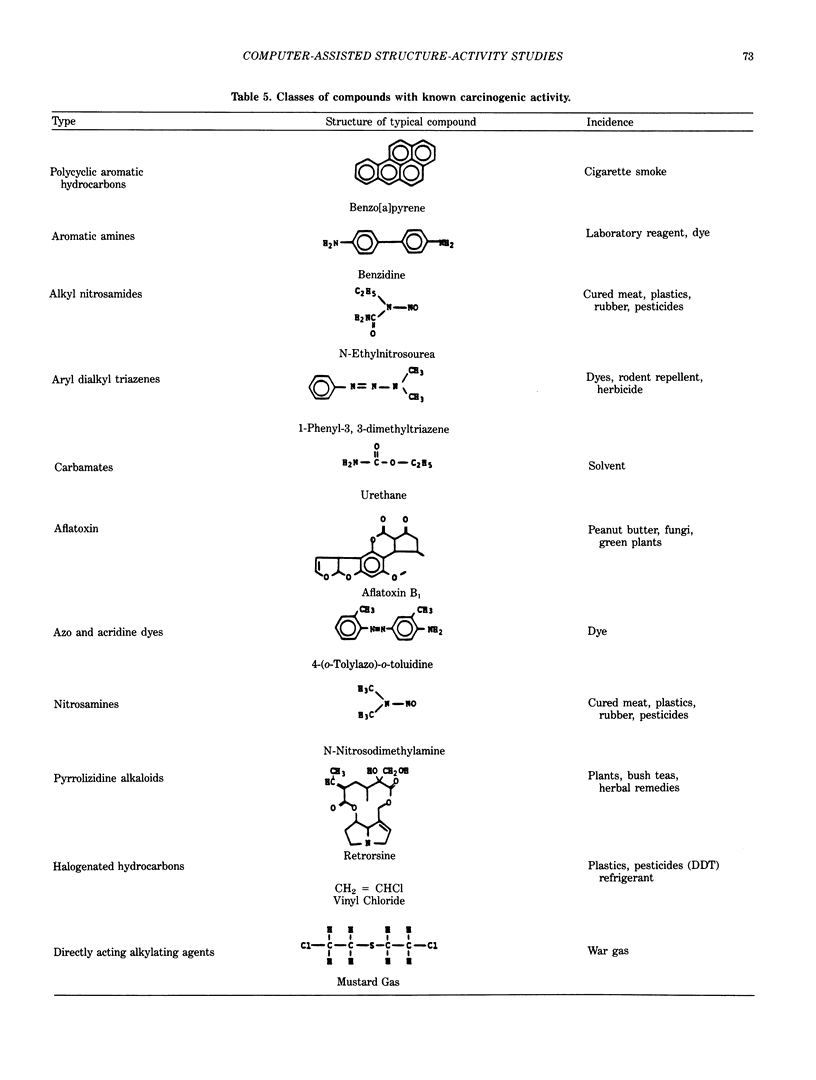
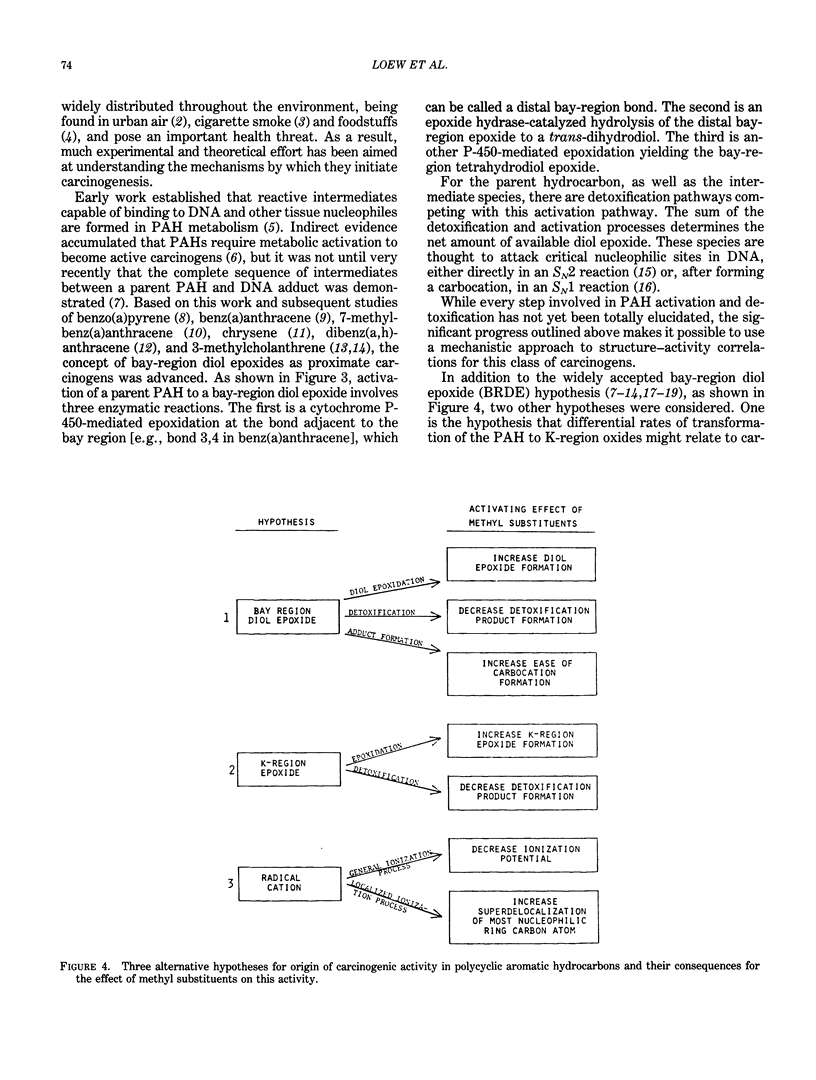
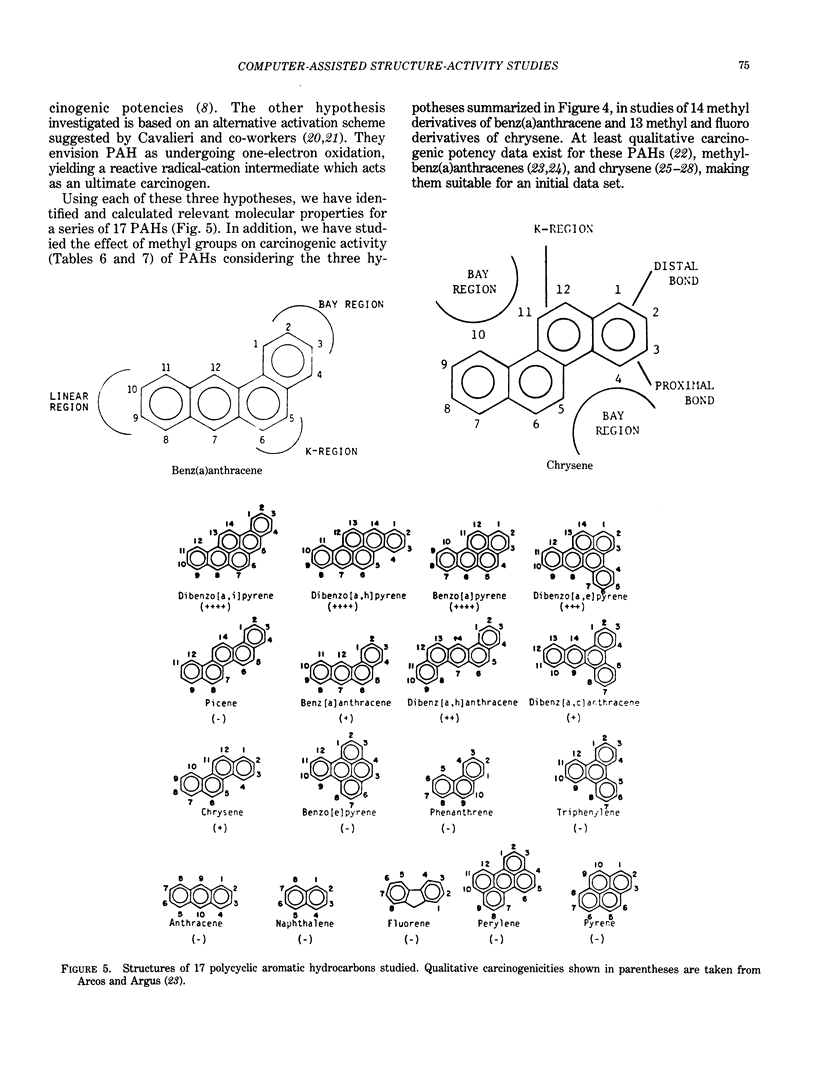
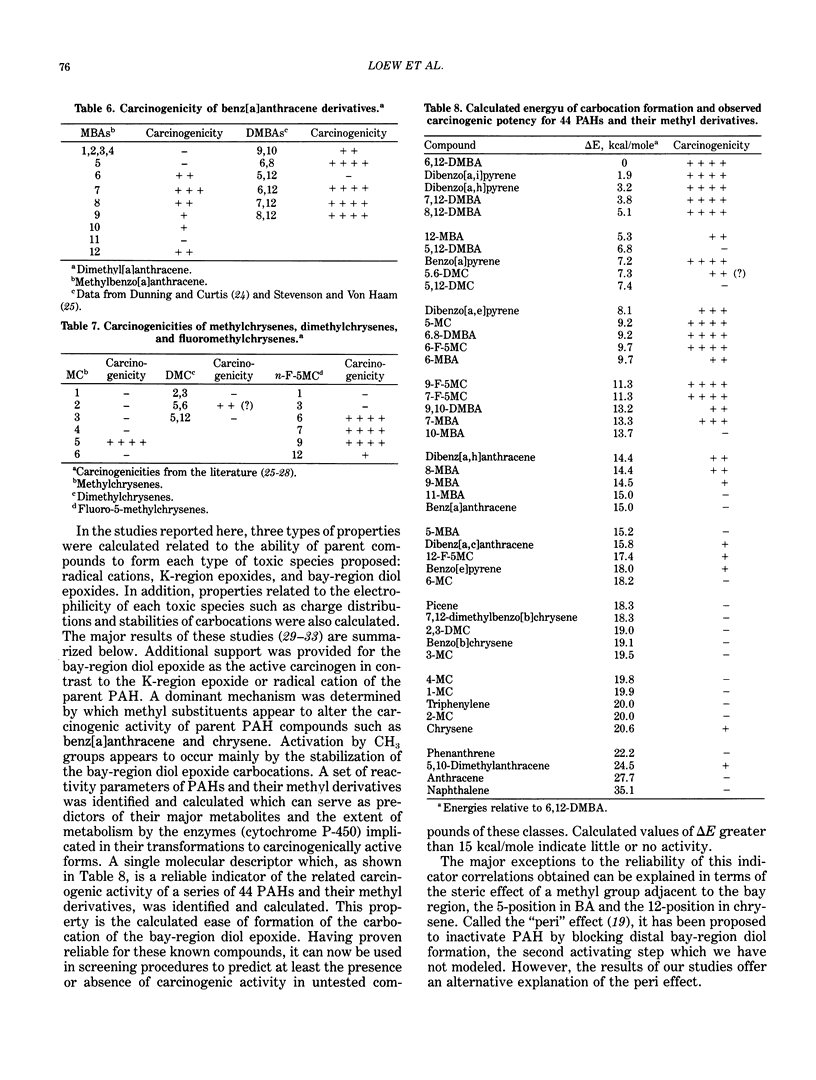
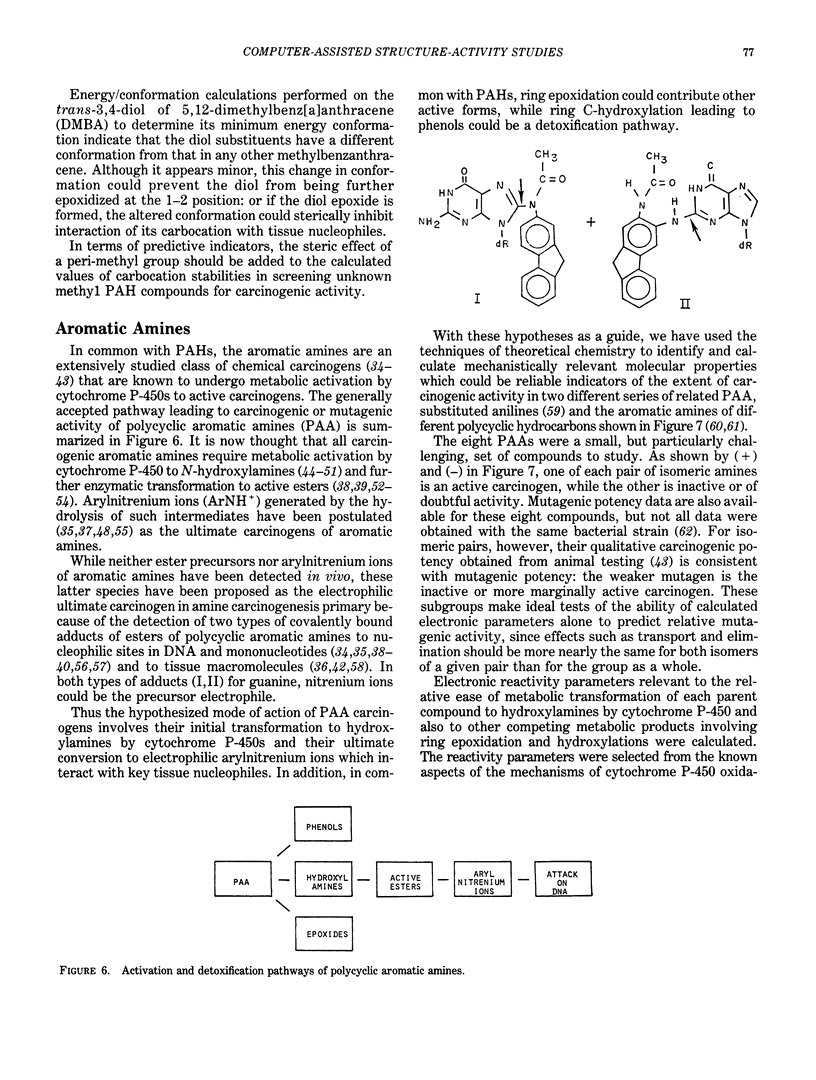
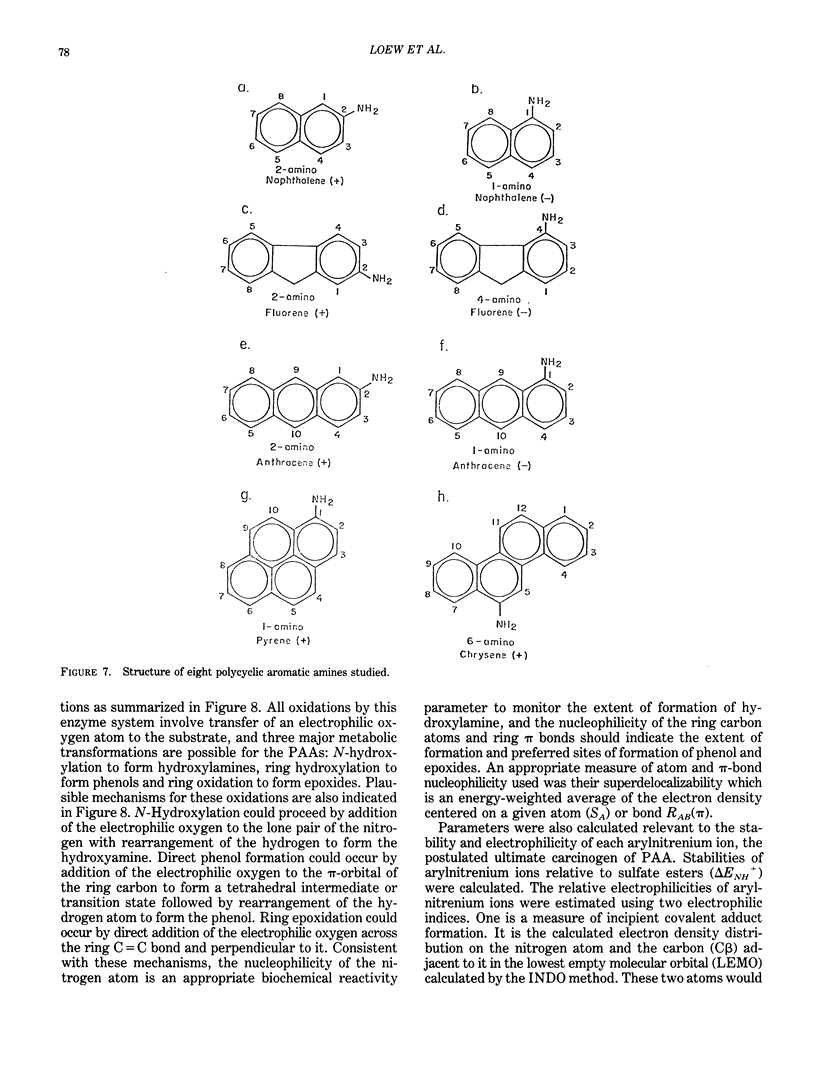
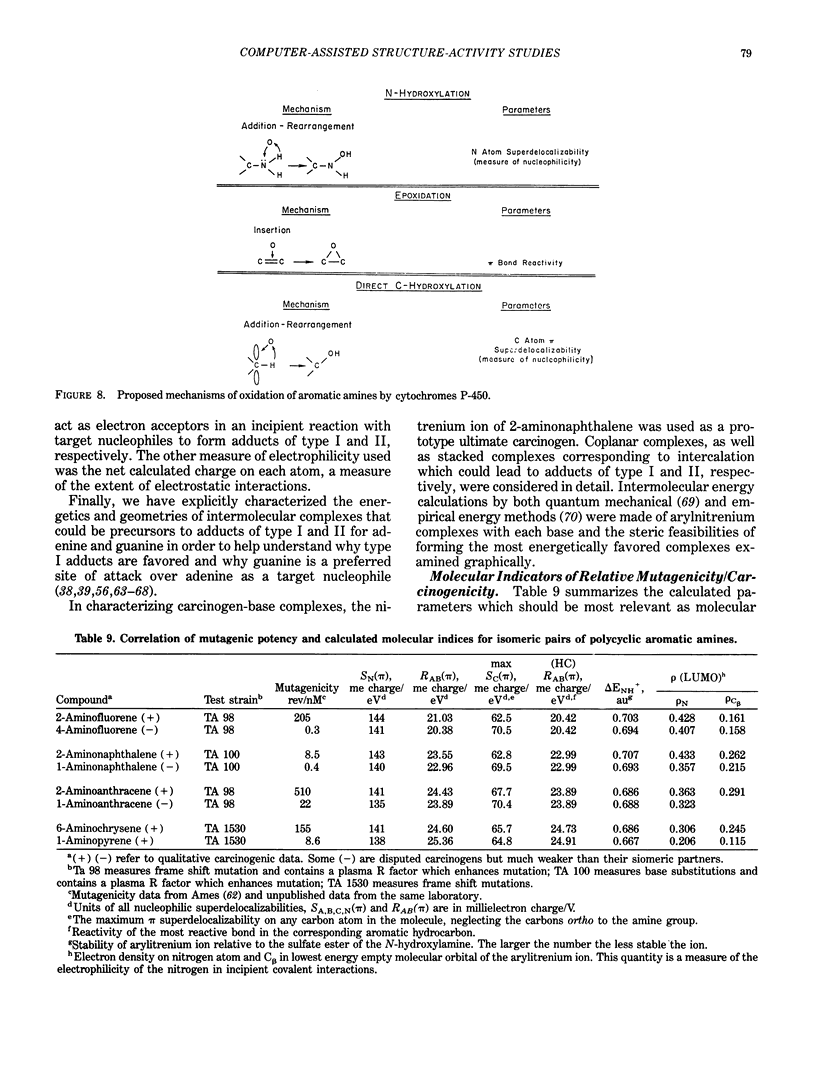
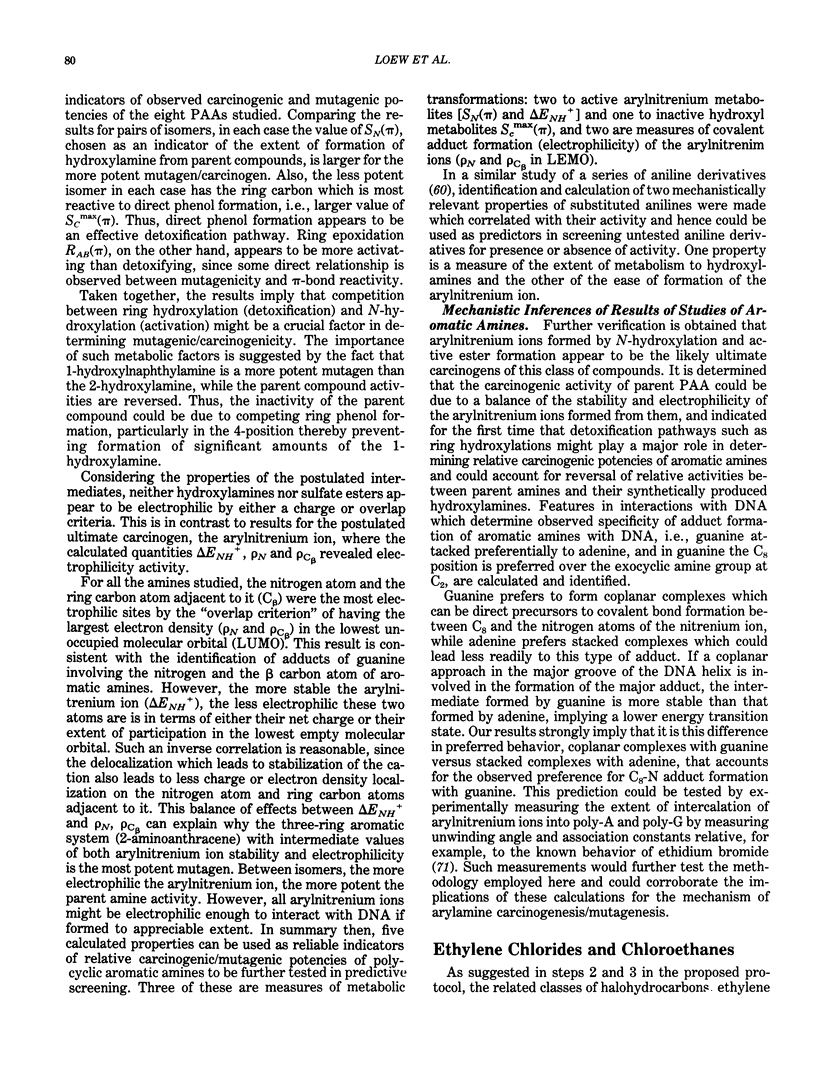
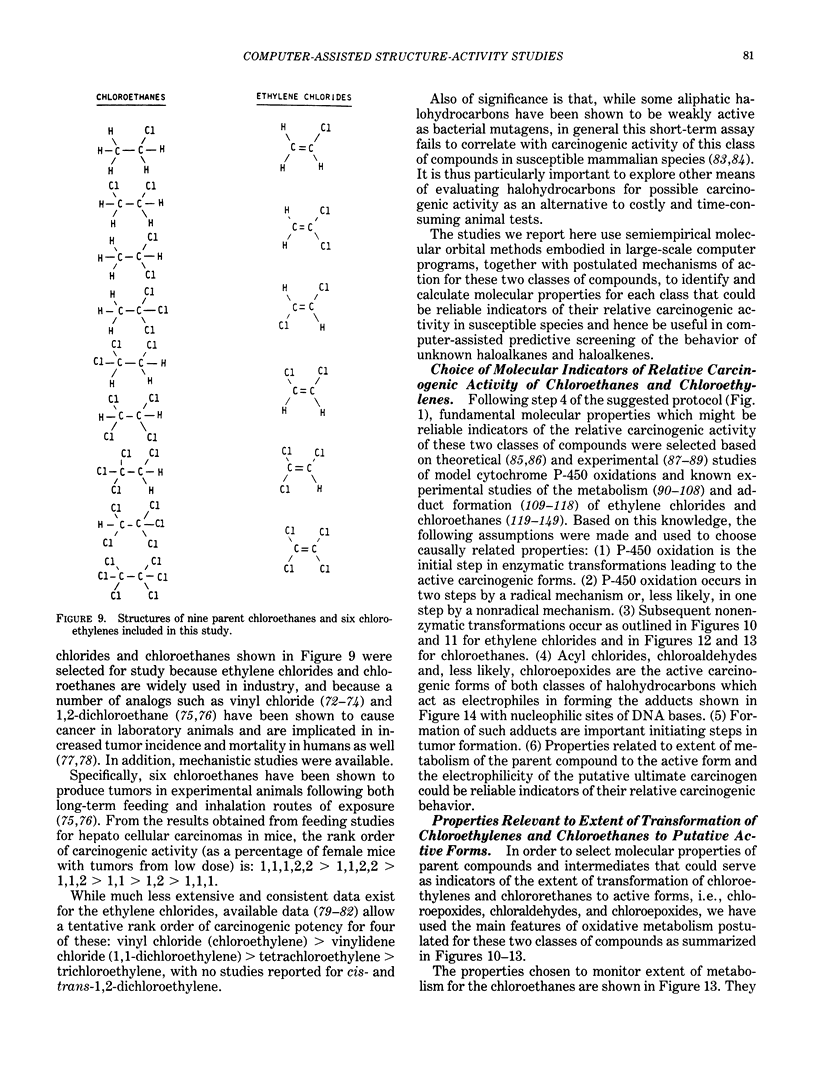
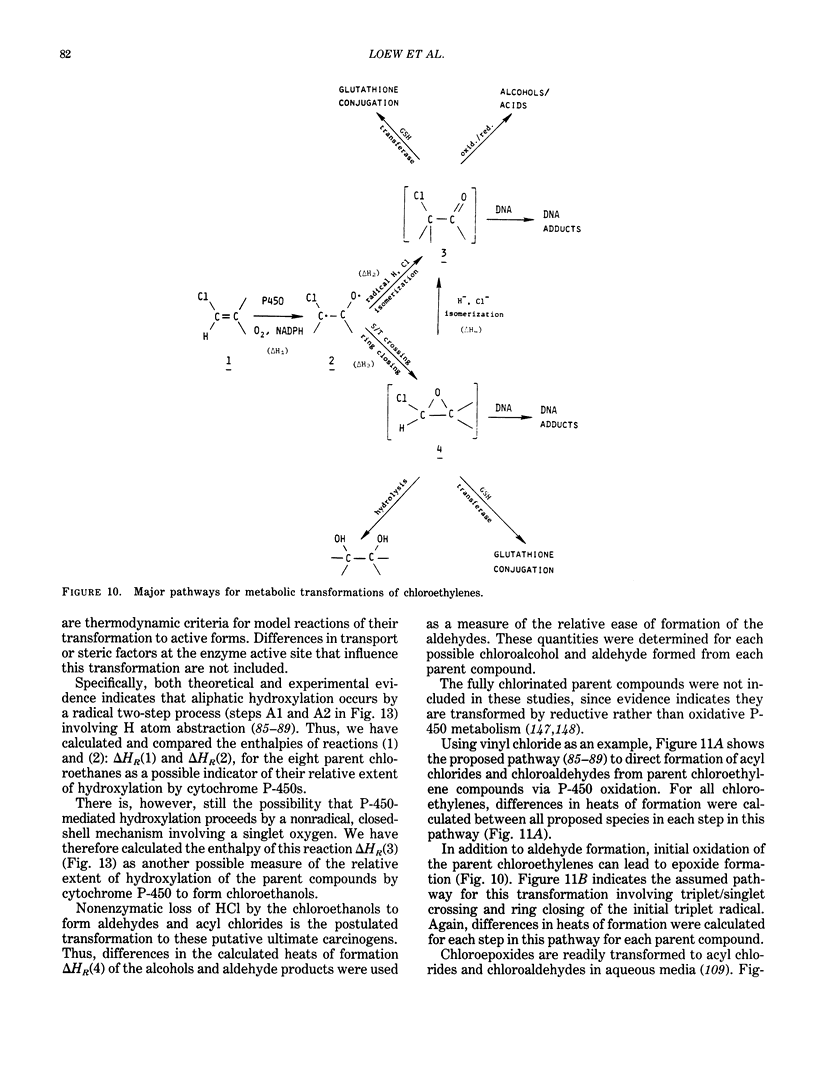
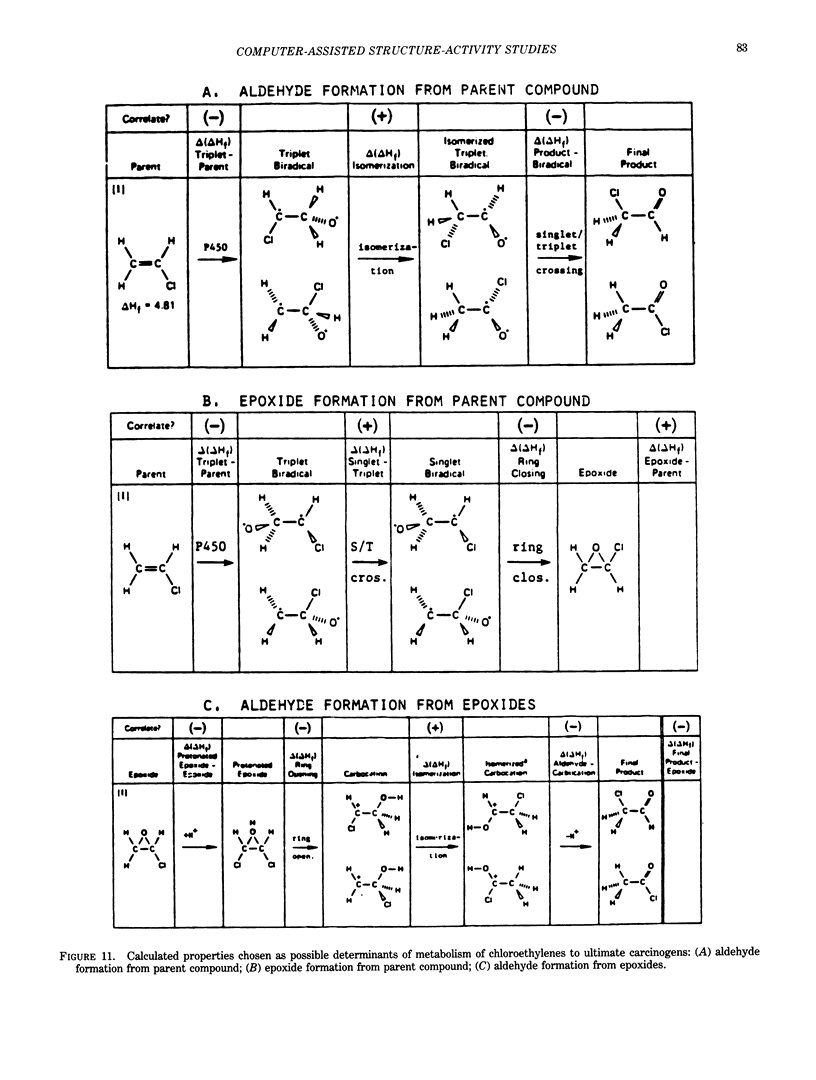
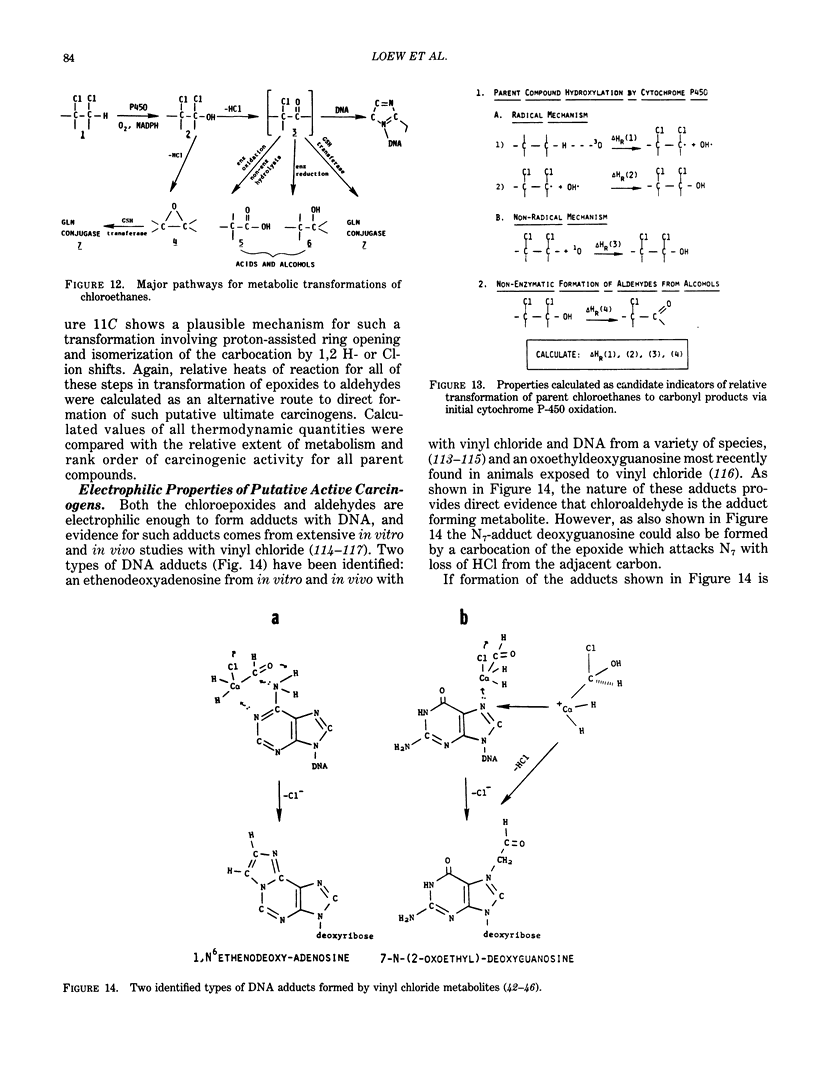
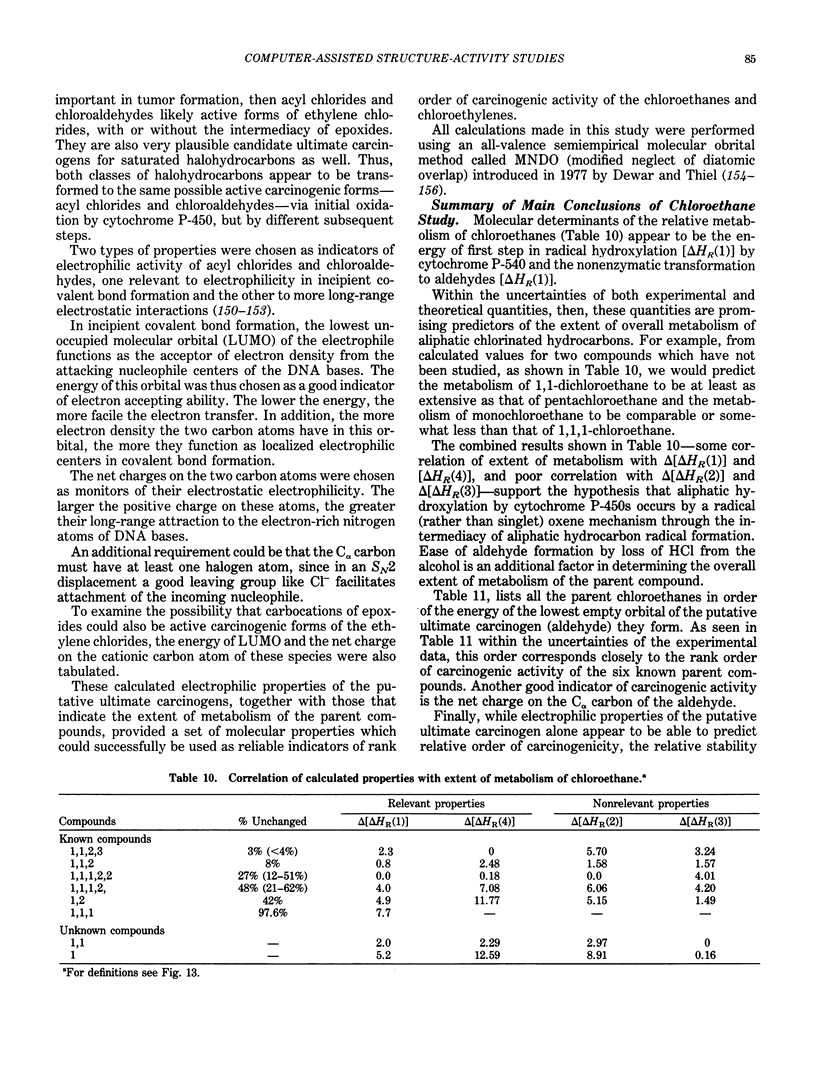
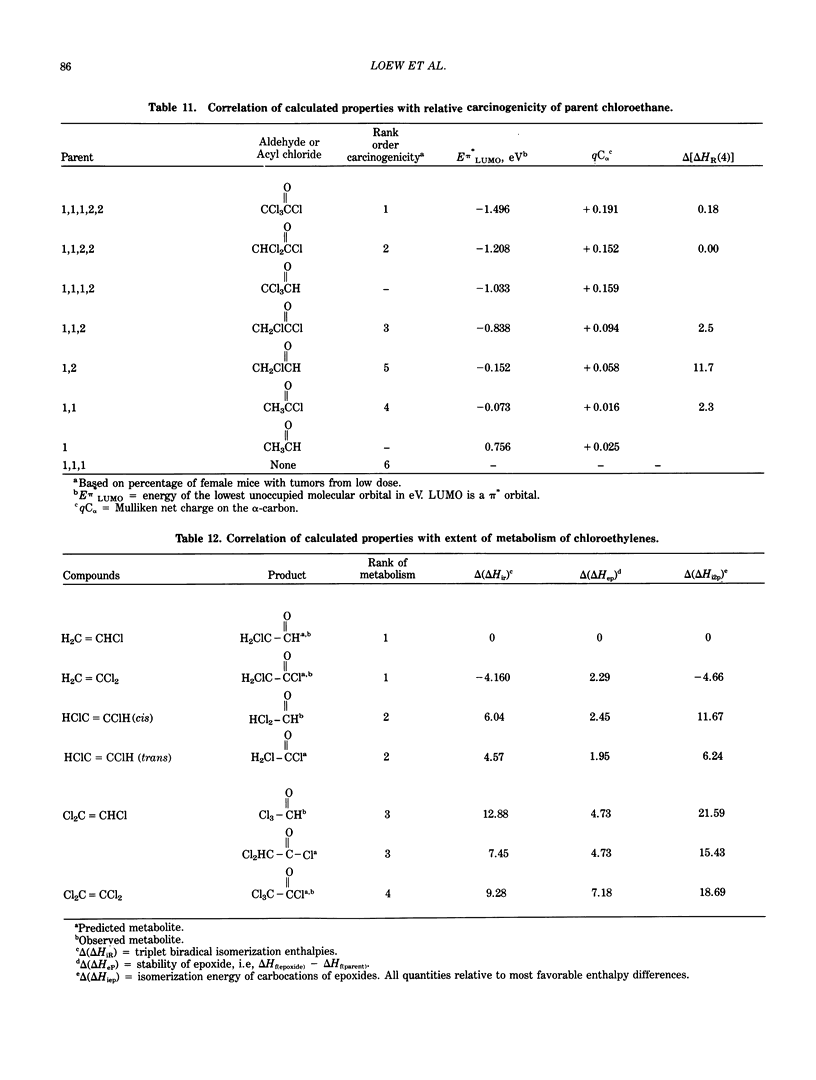
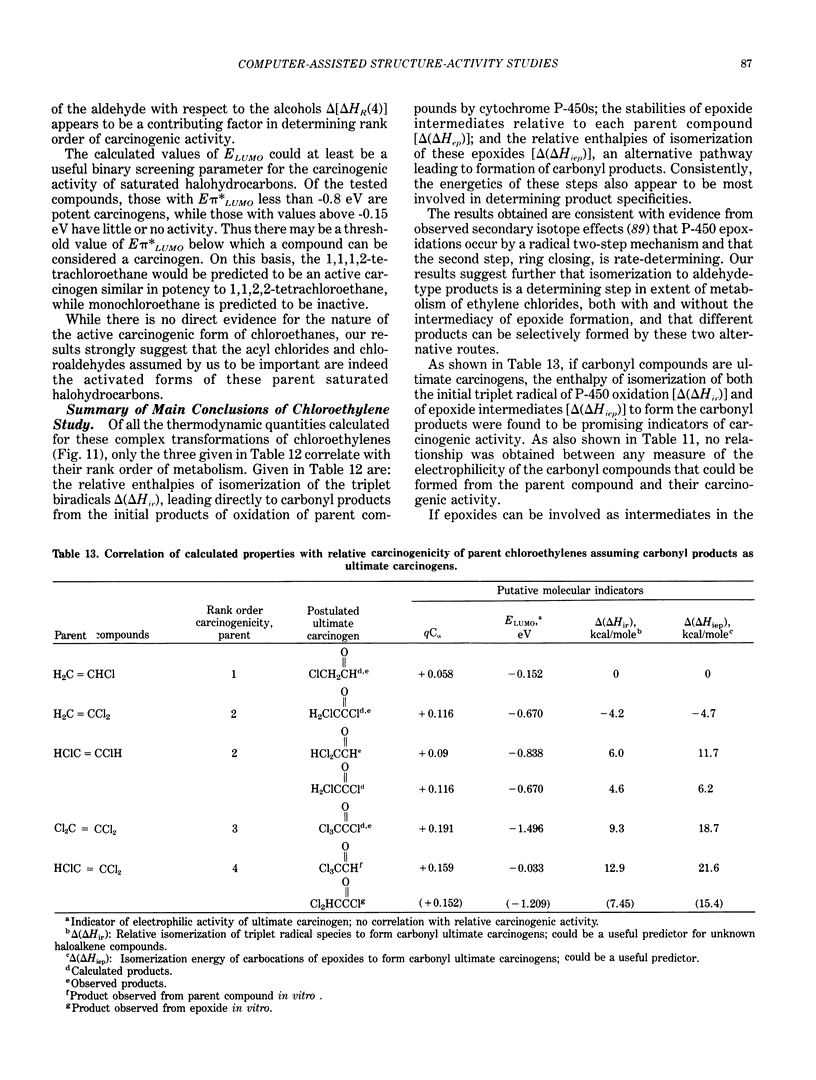
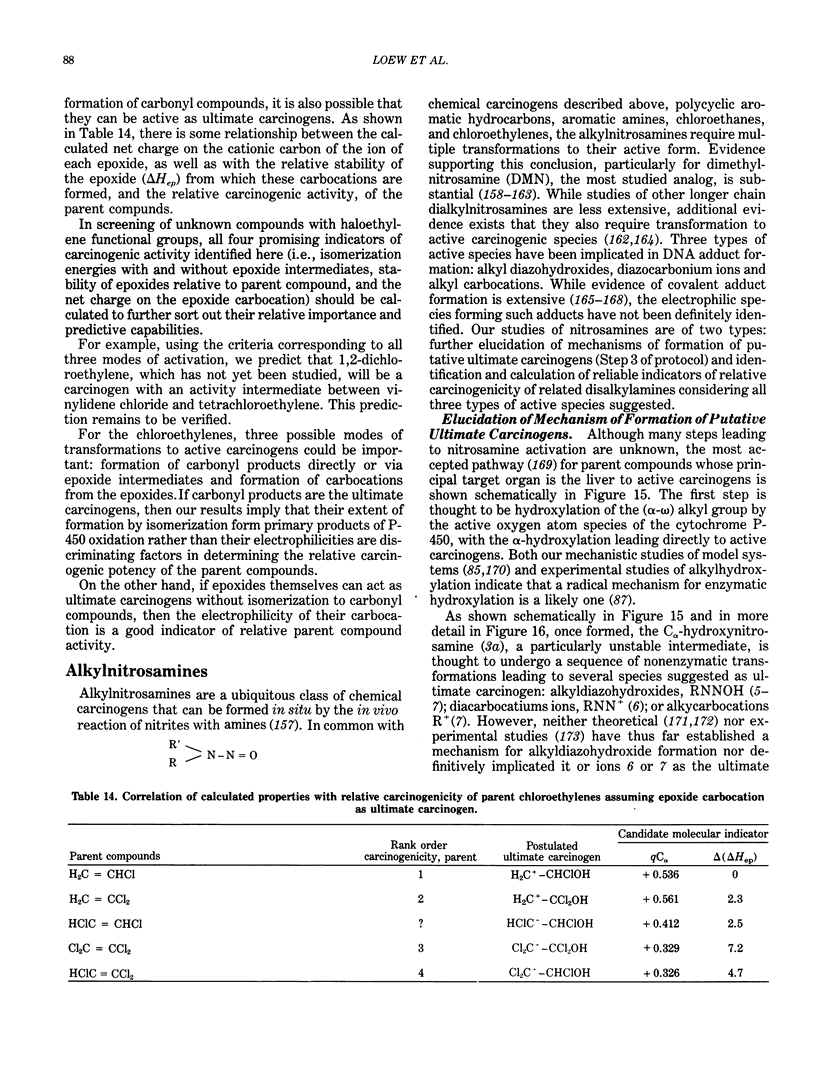
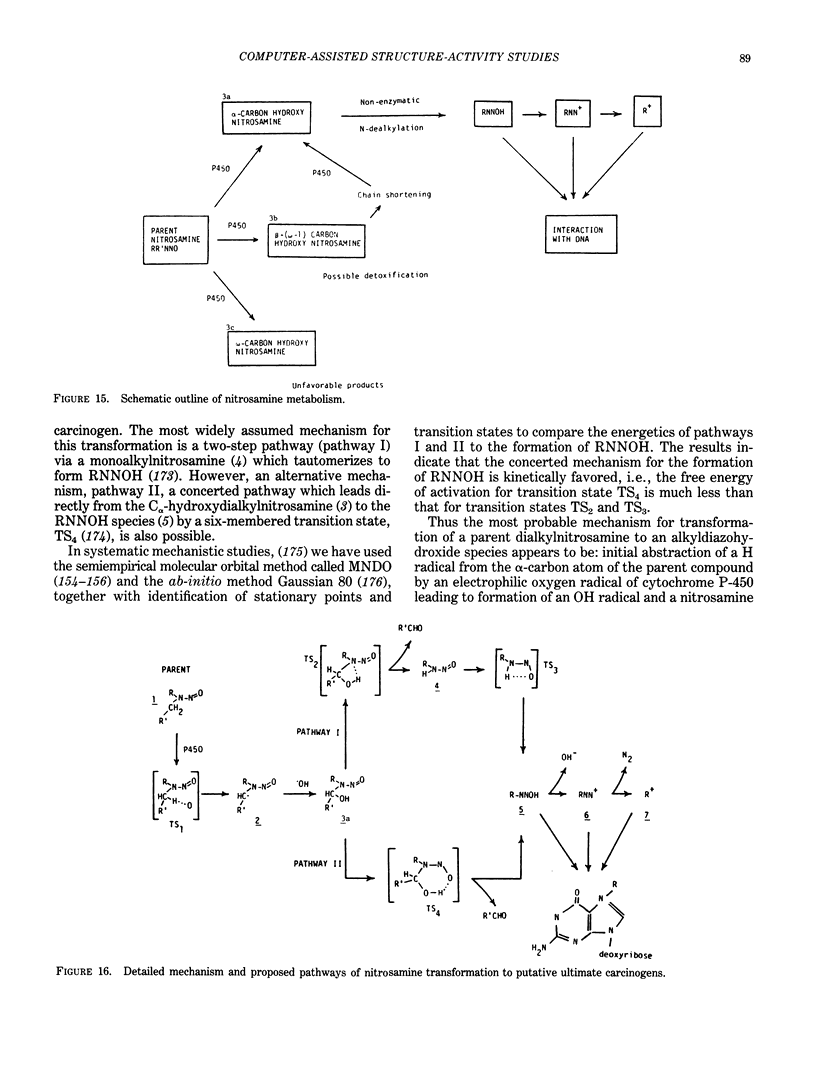
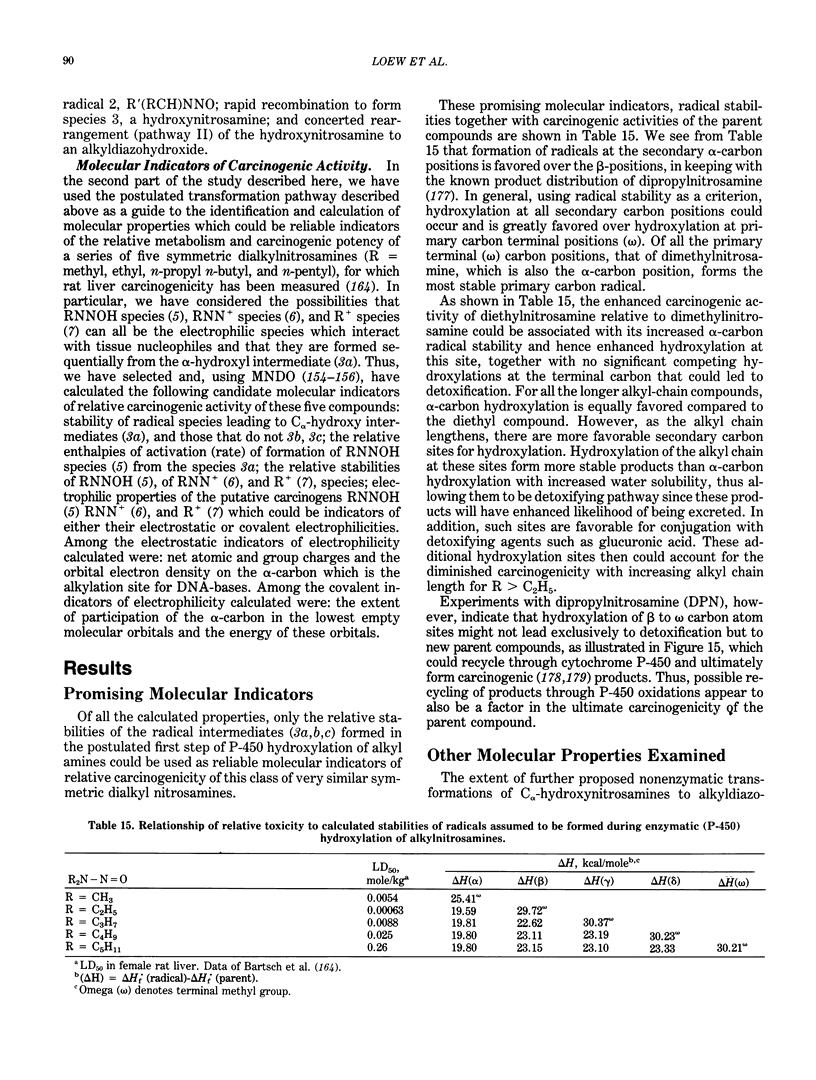
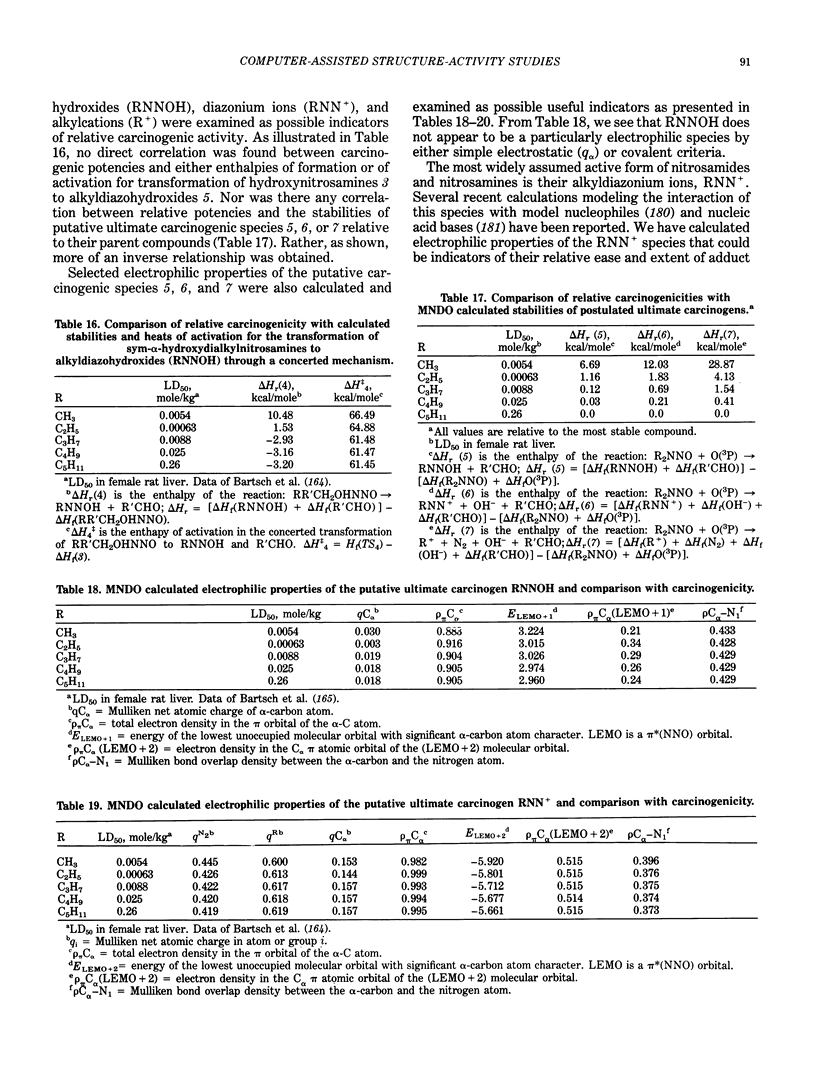
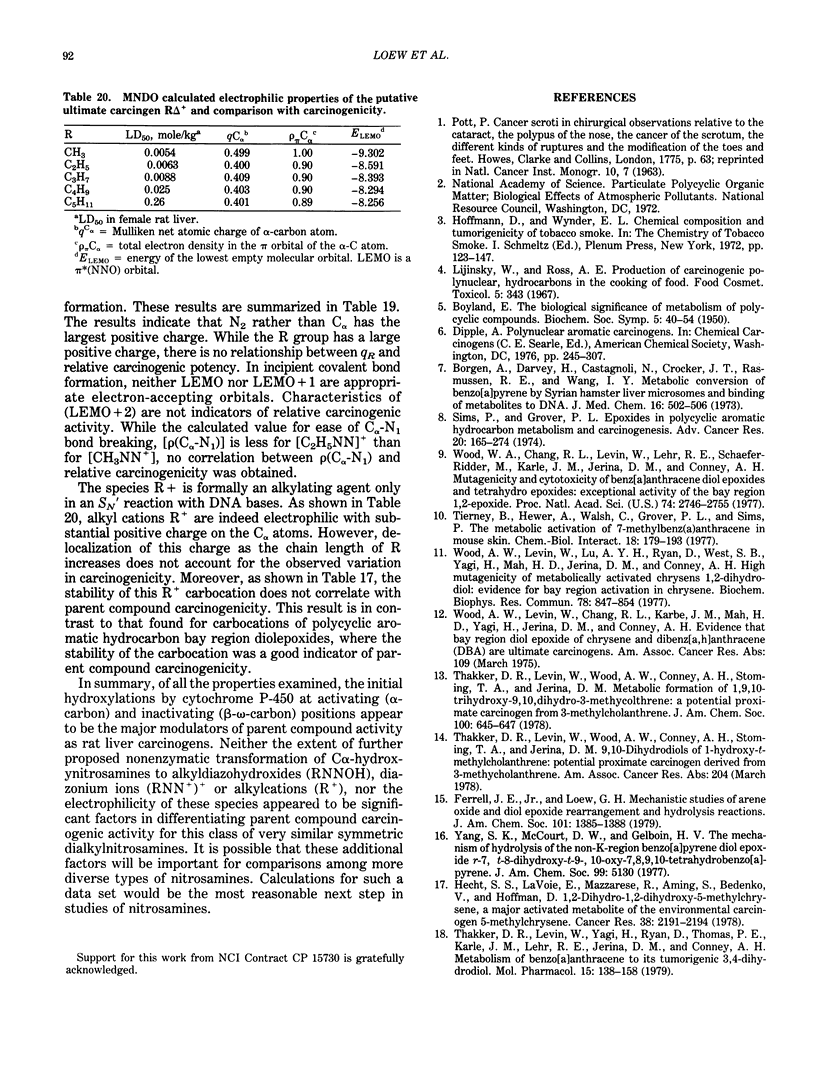
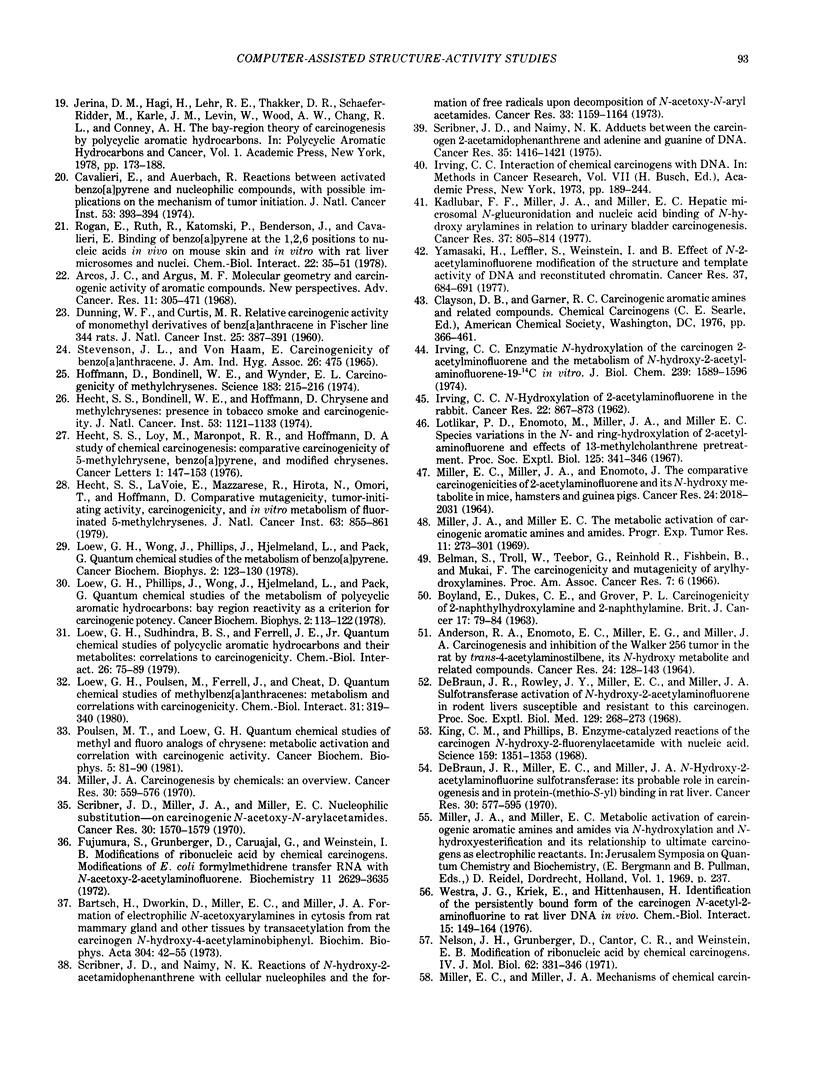
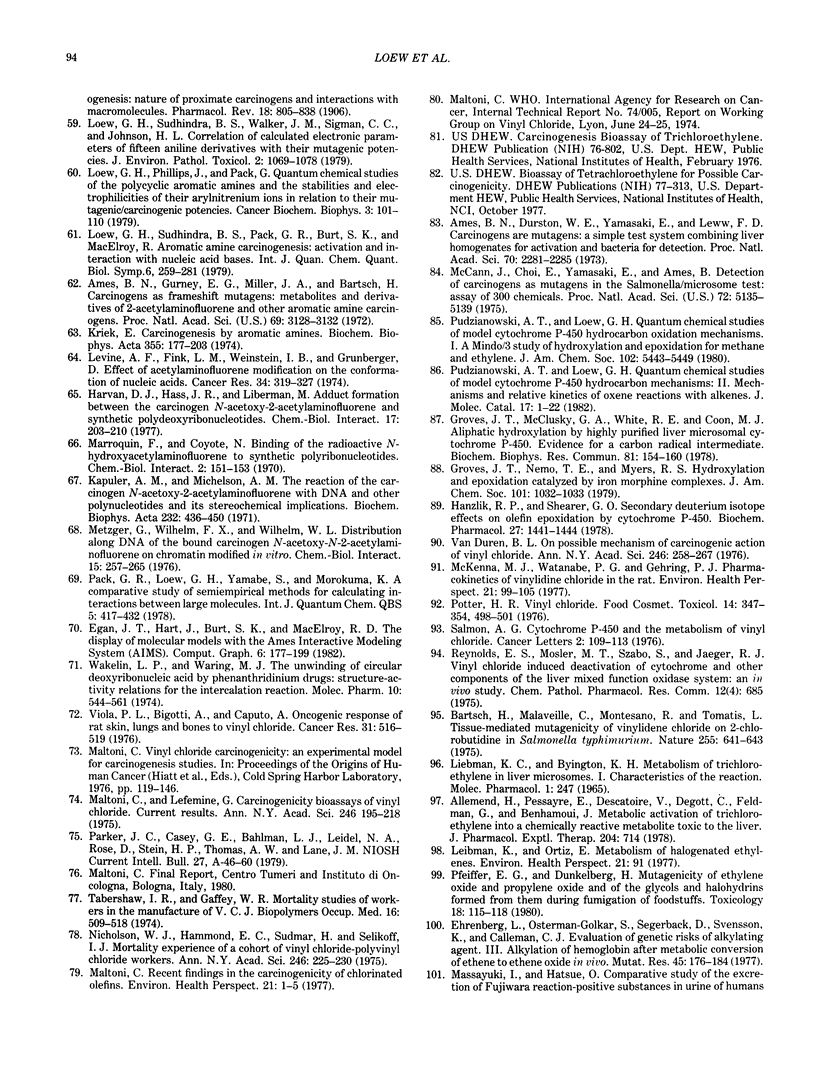
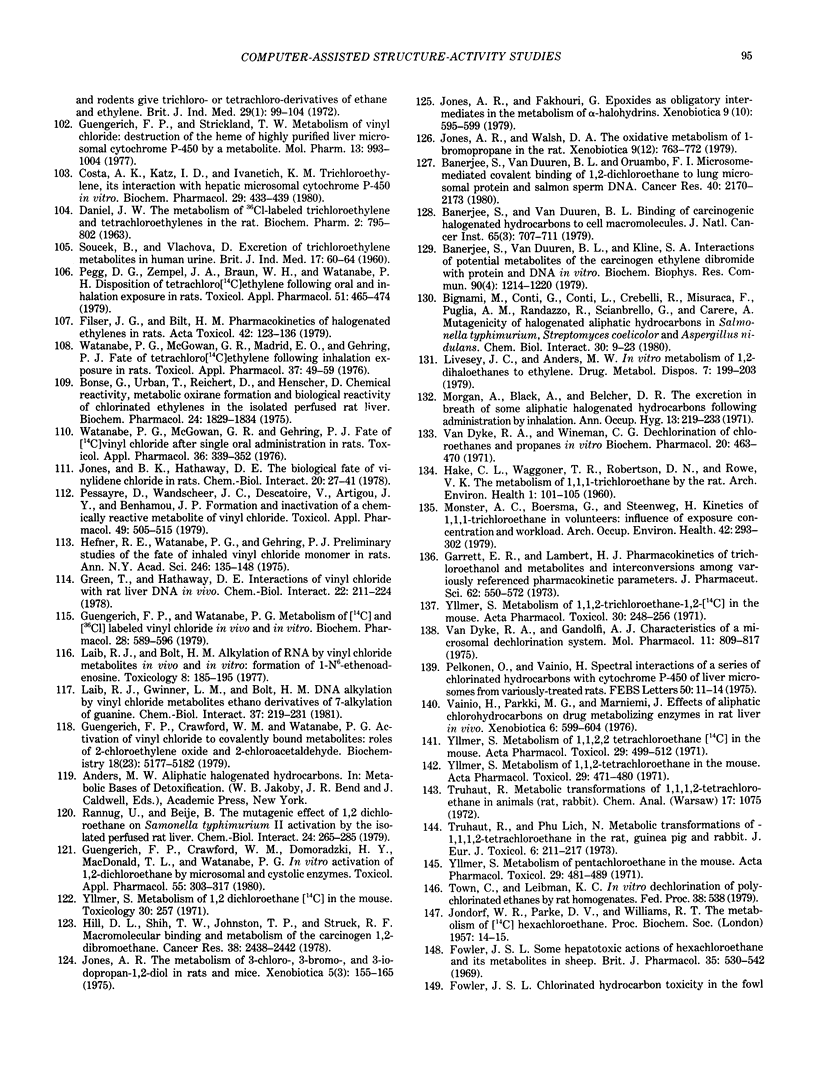
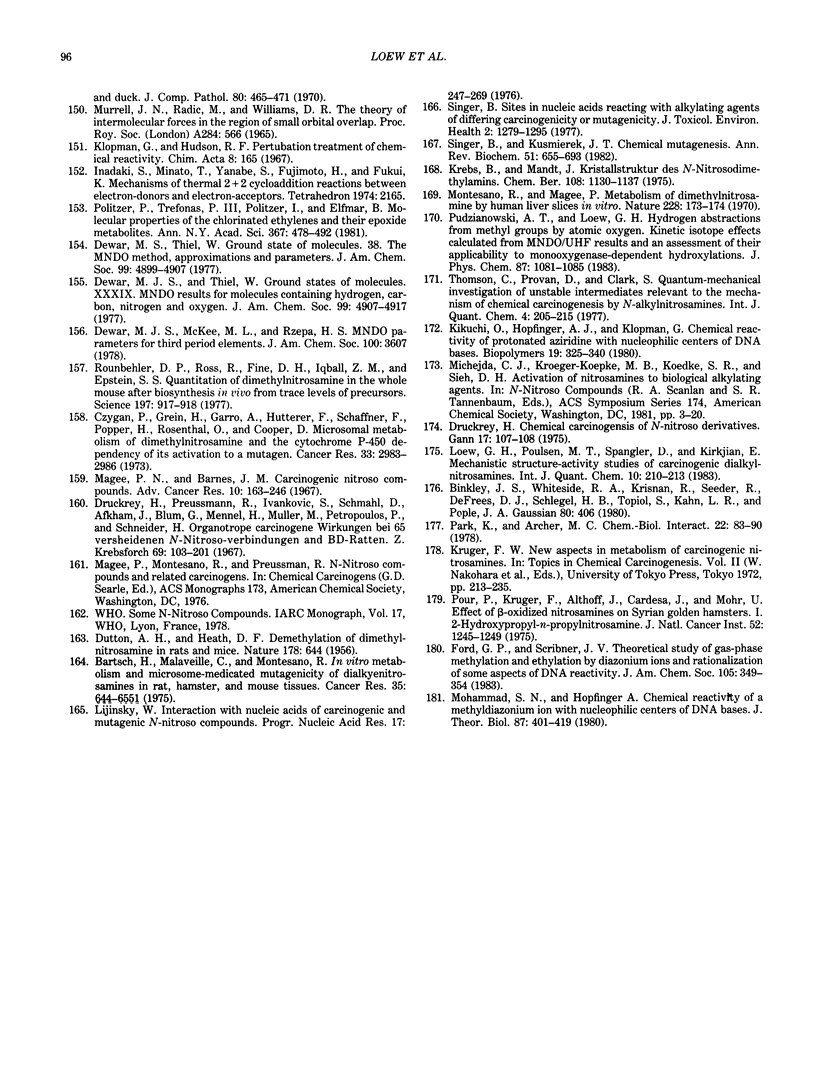
Selected References
These references are in PubMed. This may not be the complete list of references from this article.
- ANDERSEN R. A., ENOMOTO M., MILLER E. C., MILLER J. A. CARCINOGENESIS AND INHIBITION OF THE WALKER 256 TUMOR IN THE RAT BY TRANS-4-ACETYLAMINOSTILBENE, ITS N-HYDROXY METABOLITE, AND RELATED COMPOUNDS. Cancer Res. 1964 Jan;24:128–143. [PubMed] [Google Scholar]
- Allemand H., Pessayre D., Descatoire V., DeGott C., Feldmann G., Benhamou J. P. Metabolic activation of trichloroethylene into a chemically reactive metabolite toxic to the liver. J Pharmacol Exp Ther. 1978 Mar;204(3):714–723. [PubMed] [Google Scholar]
- Ames B. N., Durston W. E., Yamasaki E., Lee F. D. Carcinogens are mutagens: a simple test system combining liver homogenates for activation and bacteria for detection. Proc Natl Acad Sci U S A. 1973 Aug;70(8):2281–2285. doi: 10.1073/pnas.70.8.2281. [DOI] [PMC free article] [PubMed] [Google Scholar]
- Ames B. N., Gurney E. G., Miller J. A., Bartsch H. Carcinogens as frameshift mutagens: metabolites and derivatives of 2-acetylaminofluorene and other aromatic amine carcinogens. Proc Natl Acad Sci U S A. 1972 Nov;69(11):3128–3132. doi: 10.1073/pnas.69.11.3128. [DOI] [PMC free article] [PubMed] [Google Scholar]
- Arcos J. C., Argus M. F. Molecular geometry and carcinogenic activity of aromatic compounds. New perspectives. Adv Cancer Res. 1968;11:305–471. doi: 10.1016/s0065-230x(08)60390-5. [DOI] [PubMed] [Google Scholar]
- BOYLAND E., DUKES C. E., GROVER P. L. Carcinogenicity of 2-naphthylhydroxylamine and 2-naphthylamine. Br J Cancer. 1963 Mar;17:79–84. doi: 10.1038/bjc.1963.12. [DOI] [PMC free article] [PubMed] [Google Scholar]
- Banerjee S., Van Duuren B. L., Kline S. A. Interaction of potential metabolites of the carcinogen ethylene dibromide with protein and DNA in vitro. Biochem Biophys Res Commun. 1979 Oct 29;90(4):1214–1220. doi: 10.1016/0006-291x(79)91166-5. [DOI] [PubMed] [Google Scholar]
- Banerjee S., Van Duuren B. L., Oruambo F. I. Microsome-mediated covalent binding of 1,2-dichloroethane to lung microsomal protein and salmon sperm DNA. Cancer Res. 1980 Jul;40(7):2170–2173. [PubMed] [Google Scholar]
- Bartsch H., Dworkin C., Miller E. C., Miller J. A. Formation of electrophilic N-acetoxyarylamines in cytosoles from rat mammary gland and other tissues by transacetylation from the carcinogen N-hydroxy-4-acetylaminobiphenyl. Biochim Biophys Acta. 1973 Mar 30;304(1):42–55. doi: 10.1016/0304-4165(73)90113-x. [DOI] [PubMed] [Google Scholar]
- Bartsch H., Malaveille C., Montesano R. In vitro metabolism and microsome-mediated mutagenicity of dialkylnitrosamines in rat, hamster, and mouse tissues. Cancer Res. 1975 Mar;35(3):644–651. [PubMed] [Google Scholar]
- Bartsch H., Malaveille C., Montesano R., Tomatis L. Tissue-mediated mutagenicity of vinylidene chloride and 2-chlorobutadiene in Salmonella typhimurium. Nature. 1975 Jun 19;255(5510):641–643. doi: 10.1038/255641a0. [DOI] [PubMed] [Google Scholar]
- Bignami M., Conti G., Conti L., Crebelli R., Misuraca F., Puglia A. M., Randazzo R., Sciandrello G., Carere A. Mutagenicity of halogenated aliphatic hydrocarbons in Salmonella typhimurium, Streptomyces coelicolor and Aspergillus nidulans. Chem Biol Interact. 1980 Apr;30(1):9–23. doi: 10.1016/0009-2797(80)90110-6. [DOI] [PubMed] [Google Scholar]
- Bonse G., Urban T., Reichert D., Henschler D. Chemical reactivity, metabolic oxirane formation and biological reactivity of chlorinated ethylenes in the isolated perfused rat liver preparation. Biochem Pharmacol. 1975 Oct 1;24(19):1829–1834. doi: 10.1016/0006-2952(75)90468-2. [DOI] [PubMed] [Google Scholar]
- Borgen A., Darvey H., Castagnoli N., Crocker T. T., Rasmussen R. E., Wang I. Y. Metabolic conversion of benzo(a)pyrene by Syrian hamster liver microsomes and binding of metabolites to deoxyribonucleic acid. J Med Chem. 1973 May;16(5):502–506. doi: 10.1021/jm00263a020. [DOI] [PubMed] [Google Scholar]
- Byington K. H., Leibman K. C. Metabolism of trichloroethylene in liver microsomes. II. Identification of the reaction product as chloral hydrate. Mol Pharmacol. 1965 Nov;1(3):247–254. [PubMed] [Google Scholar]
- Cavalieri E., Auerbach R. Reactions between activated benzo(a)pyrene and nucleophilic compounds, with possible implications on the mechanism of tumor initiation. J Natl Cancer Inst. 1974 Aug;53(2):393–397. doi: 10.1093/jnci/53.2.393. [DOI] [PubMed] [Google Scholar]
- Costa A. K., Katz I. D., Ivanetich K. M. Trichloroethylene: its interaction with hepatic microsomal cytochrome P-450 in vitro. Biochem Pharmacol. 1980 Feb;29(3):433–439. doi: 10.1016/0006-2952(80)90524-9. [DOI] [PubMed] [Google Scholar]
- Czygan P., Greim H., Garro A. J., Hutterer F., Schaffner F., Popper H., Rosenthal O., Cooper D. Y. Microsomal metabolism of dimethylnitrosamine and the cytochrome P-450 dependency of its activation to a mutagen. Cancer Res. 1973 Nov;33(11):2983–2986. [PubMed] [Google Scholar]
- DANIEL J. W. THE METABOLISM OF 36C1-LABELLED TRICHLOROETHYLENE AND TETRACHLOROETHYLENE IN THE RAT. Biochem Pharmacol. 1963 Aug;12:795–802. doi: 10.1016/0006-2952(63)90109-6. [DOI] [PubMed] [Google Scholar]
- DUTTON A. H., HEATH D. F. Demethylation of dimethylnitrosamine in rats and mice. Nature. 1956 Sep 22;178(4534):644–644. doi: 10.1038/178644a0. [DOI] [PubMed] [Google Scholar]
- DeBaun J. R., Miller E. C., Miller J. A. N-hydroxy-2-acetylaminofluorene sulfotransferase: its probable role in carcinogenesis and in protein-(methion-S-yl) binding in rat liver. Cancer Res. 1970 Mar;30(3):577–595. [PubMed] [Google Scholar]
- DeBaun J. R., Rowley J. Y., Miller E. C., Miller J. A. Sulfotransferase activation of N-hydroxy-2-acetylaminofluorene in rodent livers susceptible and resistant to this carcinogen. Proc Soc Exp Biol Med. 1968 Oct;129(1):268–273. doi: 10.3181/00379727-129-33301. [DOI] [PubMed] [Google Scholar]
- Ehrenberg L., Osterman-Golkar S., Segerbäck D., Svensson K., Calleman C. J. Evaluation of genetic risks of alkylating agents. III. Alkylation of haemoglobin after metabolic conversion of ethene to ethene oxide in vivo. Mutat Res. 1977 Nov;45(2):175–184. doi: 10.1016/0027-5107(77)90017-3. [DOI] [PubMed] [Google Scholar]
- Filser J. G., Bolt H. M. Pharmacokinetics of halogenated ethylenes in rats. Arch Toxicol. 1979 Jun 8;42(2):123–136. doi: 10.1007/BF00316492. [DOI] [PubMed] [Google Scholar]
- Fowler J. S. Chlorinated hydrocarbon toxicity in the fowl and duck. J Comp Pathol. 1970 Jul;80(3):465–471. doi: 10.1016/0021-9975(70)90079-4. [DOI] [PubMed] [Google Scholar]
- Fowler J. S. Some hepatotoxic actions of hexachloroethane and its metabolites in sheep. Br J Pharmacol. 1969 Mar;35(3):530–542. doi: 10.1111/j.1476-5381.1969.tb08294.x. [DOI] [PMC free article] [PubMed] [Google Scholar]
- Fujimura S., Grunberger D., Carvajal G., Weinstein I. B. Modifications of ribonucleic acid by chemical carcinogens. Modification of Escherichia coli formylmethionine transfer ribonucleic acid with N-acetoxy-2-acetylaminofluorene. Biochemistry. 1972 Sep 12;11(19):3629–3635. doi: 10.1021/bi00769a021. [DOI] [PubMed] [Google Scholar]
- Garrett E. R., Lambert H. J. Pharmacokinetics of trichloroethanol and metabolites and interconversions among variously referenced pharmacokinetic parameters. J Pharm Sci. 1973 Apr;62(4):550–572. doi: 10.1002/jps.2600620404. [DOI] [PubMed] [Google Scholar]
- Green T., Hathway D. E. Interactions of vinyl chloride with rat-liver DNA in vivo. Chem Biol Interact. 1978 Sep;22(2-3):211–224. doi: 10.1016/0009-2797(78)90126-6. [DOI] [PubMed] [Google Scholar]
- Groves J. T., McClusky G. A. Aliphatic hydroxylation by highly purified liver microsomal cytochrome P-450. Evidence for a carbon radical intermediate. Biochem Biophys Res Commun. 1978 Mar 15;81(1):154–160. doi: 10.1016/0006-291x(78)91643-1. [DOI] [PubMed] [Google Scholar]
- Guengerich F. P., Crawford W. M., Jr, Domoradzki J. Y., Macdonald T. L., Watanabe P. G. In vitro activation of 1,2-dichloroethane by microsomal and cytosolic enzymes. Toxicol Appl Pharmacol. 1980 Sep 15;55(2):303–317. doi: 10.1016/0041-008x(80)90092-7. [DOI] [PubMed] [Google Scholar]
- Guengerich F. P., Crawford W. M., Jr, Watanabe P. G. Activation of vinyl chloride to covalently bound metabolites: roles of 2-chloroethylene oxide and 2-chloroacetaldehyde. Biochemistry. 1979 Nov 13;18(23):5177–5182. doi: 10.1021/bi00590a023. [DOI] [PubMed] [Google Scholar]
- Guengerich F. P., Strickland T. W. Metabolism of vinyl chloride: destruction of the heme of highly purified liver Microsomal cytochrome P-450 by a metabolite. Mol Pharmacol. 1977 Nov;13(6):993–1004. [PubMed] [Google Scholar]
- Guengerich F. P., Watanabe P. G. Metabolism of [14C]- and [36C]-labeled vinyl chloride in vivo and in vitro. Biochem Pharmacol. 1979 Mar 1;28(5):589–596. doi: 10.1016/0006-2952(79)90140-0. [DOI] [PubMed] [Google Scholar]
- HAKE C. L., WAGGONER T. B., ROBERTSON D. N., ROWE V. K. The metabolism of 1,1,1-trichloroethane by the rat. Arch Environ Health. 1960 Aug;1:101–105. doi: 10.1080/00039896.1960.10662673. [DOI] [PubMed] [Google Scholar]
- Hanzlik R. P., Shearer G. O. Secondary deuterium isotope effects on olefin epoxidation by cytochrome P-450. Biochem Pharmacol. 1978 May 15;27(10):1441–1444. doi: 10.1016/0006-2952(78)90099-0. [DOI] [PubMed] [Google Scholar]
- Harvan D. J., Hass J. R., Lieberman M. W. Adduct formation between the carcinogen N-acetoxy-2-acetylaminofluorene and synthetic polydeoxyribonucleotides. Chem Biol Interact. 1977 May;17(2):203–210. doi: 10.1016/0009-2797(77)90085-0. [DOI] [PubMed] [Google Scholar]
- Hecht S. S., Bondinell W. E., Hoffmann D. Chrysene and methylchrysenes: presence in tobacco smoke and carcinogenicity. J Natl Cancer Inst. 1974 Oct;53(4):1121–1133. doi: 10.1093/jnci/53.4.1121. [DOI] [PubMed] [Google Scholar]
- Hecht S. S., LaVoie E., Mazzarese R., Amin S., Bedenko V., Hoffmann D. 1,2-dihydro-1,2-dihydroxy-5-methylchrysene, a major activated metabolite of the environmental carcinogen 5-methylchrysene. Cancer Res. 1978 Jul;38(7):2191–2194. [PubMed] [Google Scholar]
- Hecht S. S., LaVole E., Mazzarese R., Hirota N., Ohmori T., Hoffmann D. Comparative mutagenicity, tumor-initiating activity, carcinogenicity, and in vitro metabolism of fluorinated 5-methylchrysenes. J Natl Cancer Inst. 1979 Sep;63(3):855–861. doi: 10.1093/jnci/63.3.855. [DOI] [PubMed] [Google Scholar]
- Hill D. L., Shih T. W., Johnston T. P., Struck R. F. Macromolecular binding and metabolism of the carcinogen 1,2-dibromoethane. Cancer Res. 1978 Aug;38(8):2438–2442. [PubMed] [Google Scholar]
- Hoffmann D., Bondinell W. E., Wynder E. L. Carcinogenicity of methylchrysenes. Science. 1974 Jan 18;183(4121):215–216. doi: 10.1126/science.183.4121.215. [DOI] [PubMed] [Google Scholar]
- IRVING C. C. ENZYMATIC N-HYDROXYLATION OF THE CARCINOGEN 2-ACETYLAMINOFLUORENE AND THE METABOLISM OF N-HYDROXY-2-ACETYLAMINOFLUORENE-9-14C IN VITRO. J Biol Chem. 1964 May;239:1589–1596. [PubMed] [Google Scholar]
- Jones A. R., Fakhouri G. Epoxides as obligatory intermediates in the metabolism of alpha-halohydrins. Xenobiotica. 1979 Oct;9(10):595–599. doi: 10.3109/00498257909042326. [DOI] [PubMed] [Google Scholar]
- Jones A. R. The metabolism of 3-chloro,- 3-bromo- and 3-iodoprpan-1,2-diol in rats and mice. Xenobiotica. 1975 Mar;5(3):155–165. doi: 10.3109/00498257509056101. [DOI] [PubMed] [Google Scholar]
- Jones A. R., Walsh D. A. The oxidative metabolism of 1-bromopropane in the rat. Xenobiotica. 1979 Dec;9(12):763–772. doi: 10.3109/00498257909042344. [DOI] [PubMed] [Google Scholar]
- Jones B. K., Hathway D. E. The biological fate of vinylidene chloride in rats. Chem Biol Interact. 1978 Jan;20(1):27–41. doi: 10.1016/0009-2797(78)90078-9. [DOI] [PubMed] [Google Scholar]
- Kadlubar F. F., Miller J. A., Miller E. C. Hepatic microsomal N-glucuronidation and nucleic acid binding of N-hydroxy arylamines in relation to urinary bladder carcinogenesis. Cancer Res. 1977 Mar;37(3):805–814. [PubMed] [Google Scholar]
- Kapuler A. M., Michelson A. M. The reaction of the carcinogen N-acetoxy-2-acetyl-aminofluorene with DNA and other polynucleotides and its stereochemical implications. Biochim Biophys Acta. 1971 Mar 25;232(3):436–450. doi: 10.1016/0005-2787(71)90598-3. [DOI] [PubMed] [Google Scholar]
- Kikuchi O., Hopfinger A. J., Klopman G. Chemical reactivity of protonated aziridine with nucleophilic centers of DNA bases. Biopolymers. 1980 Feb;19(2):325–340. doi: 10.1002/bip.1980.360190210. [DOI] [PubMed] [Google Scholar]
- King C. M., Phillips B. Enzyme-catalyzed reactions of the carcinogen N-hydroxy-2-fluorenylacetamide with nucleic acid. Science. 1968 Mar 22;159(3821):1351–1353. doi: 10.1126/science.159.3821.1351. [DOI] [PubMed] [Google Scholar]
- Kriek E. Carcinogenesis by aromatic amines. Biochim Biophys Acta. 1974 Sep 9;355(2):177–203. doi: 10.1016/0304-419x(74)90003-1. [DOI] [PubMed] [Google Scholar]
- Laib R. J., Bolt H. M. Alkylation of RNA by vinyl chloride metabolites in vitro and in vivo: formation of 1-N(6)-etheno-adenosine. Toxicology. 1977 Oct;8(2):185–195. doi: 10.1016/0300-483x(77)90007-5. [DOI] [PubMed] [Google Scholar]
- Laib R. J., Gwinner L. M., Bolt H. M. DNA alkylation by vinyl chloride metabolites: etheno derivatives or 7-alkylation of guanine? Chem Biol Interact. 1981 Oct;37(1-2):219–231. doi: 10.1016/0009-2797(81)90179-4. [DOI] [PubMed] [Google Scholar]
- Levine A. F., Fink L. M., Weinstein I. B., Grunberger D. Effect of N-2-acetylaminofluorene modification on the conformation of nucleic acids. Cancer Res. 1974 Feb;34(2):319–327. [PubMed] [Google Scholar]
- Lijinsky W. Interaction with nucleic acids of carcinogenic and mutagenic N-nitroso compounds. Prog Nucleic Acid Res Mol Biol. 1976;17:247–269. doi: 10.1016/s0079-6603(08)60072-0. [DOI] [PubMed] [Google Scholar]
- Lijinsky W., Ross A. E. Production of carcinogenic polynuclear hydrocarbons in the cooking of food. Food Cosmet Toxicol. 1967 Aug;5(3):343–347. doi: 10.1016/s0015-6264(67)83061-x. [DOI] [PubMed] [Google Scholar]
- Livesey J. C., Anders M. W. In vitro metabolism of 1,2-dihaloethanes to ethylene. Drug Metab Dispos. 1979 Jul-Aug;7(4):199–203. [PubMed] [Google Scholar]
- Loew G. H., Phillips J., Pack G. Quantum chemical studies of the metabolism of polycyclic aromatic amines and the stabilities and electrophilicities of their arylnitrenium ions in relation to their mutagenic/carcinogenic potencies. Cancer Biochem Biophys. 1979;3(3):101–110. [PubMed] [Google Scholar]
- Loew G. H., Sudhindra B. S., Ferrell J. E., Jr Quantum chemical studies of polycyclic aromatic hydrocarbons and their metabolites: correlations to carcinogenicity. Chem Biol Interact. 1979 Jun;26(1):75–89. doi: 10.1016/0009-2797(79)90094-2. [DOI] [PubMed] [Google Scholar]
- Loew G. H., Sudhindra B. S., Walker J. M., Sigman C. C., Johnson H. L. Correlation of calculated electronic parameters of fifteen aniline derivatives with their mutagenic potencies. J Environ Pathol Toxicol. 1979 Mar-Apr;2(4):1069–1078. [PubMed] [Google Scholar]
- Loew G., Poulsen M., Ferrell J., Chaet D. Quantum chemical studies of methylbenz[a]anthracenes: metabolism and correlations with carcinogenicity. Chem Biol Interact. 1980 Sep;31(3):319–340. doi: 10.1016/0009-2797(80)90020-4. [DOI] [PubMed] [Google Scholar]
- Lotlikar P. D., Enomoto M., Miller J. A., Miller E. C. Species variations in the N- and ring-hydroxylation of 2-acetylaminofluorene and effects of 3-methylcholanthrene pretreatment. Proc Soc Exp Biol Med. 1967 Jun;125(2):341–346. doi: 10.3181/00379727-125-32086. [DOI] [PubMed] [Google Scholar]
- MILLER E. C., MILLER J. A., ENOMOTO M. THE COMPARATIVE CARCINOGENICITIES OF 2-ACETYLAMINOFLUORENE AND ITS N-HYDROXY METABOLITE IN MICE, HAMSTERS, AND GUINEA PIGS. Cancer Res. 1964 Dec;24:2018–2031. [PubMed] [Google Scholar]
- Magee P. N., Barnes J. M. Carcinogenic nitroso compounds. Adv Cancer Res. 1967;10:163–246. doi: 10.1016/s0065-230x(08)60079-2. [DOI] [PubMed] [Google Scholar]
- Maltoni C., Lefemine G. Carcinogenicity bioassays of vinyl chloride: current results. Ann N Y Acad Sci. 1975 Jan 31;246:195–218. doi: 10.1111/j.1749-6632.1975.tb51094.x. [DOI] [PubMed] [Google Scholar]
- Maltoni C. Recent findings on the carcinogenicity of chlorinated olefins. Environ Health Perspect. 1977 Dec;21:1–5. doi: 10.1289/ehp.77211. [DOI] [PMC free article] [PubMed] [Google Scholar]
- Marroquin F., Coyote N. Binding of radioactive N-hydroxy-acetylaminofluorene to synthetic polyribonucleotides. Chem Biol Interact. 1970 Aug;2(2):151–153. doi: 10.1016/0009-2797(70)90046-3. [DOI] [PubMed] [Google Scholar]
- McCann J., Choi E., Yamasaki E., Ames B. N. Detection of carcinogens as mutagens in the Salmonella/microsome test: assay of 300 chemicals. Proc Natl Acad Sci U S A. 1975 Dec;72(12):5135–5139. doi: 10.1073/pnas.72.12.5135. [DOI] [PMC free article] [PubMed] [Google Scholar]
- McKenna M. J., Watanabe P. G., Gehring P. J. Pharmacokinetics of vinylidene chloride in the rat. Environ Health Perspect. 1977 Dec;21:99–105. doi: 10.1289/ehp.772199. [DOI] [PMC free article] [PubMed] [Google Scholar]
- Metzger G., Wilhelm F. X., Wilhelm M. L. Distribution along DNA of the bound carcinogen N-acetoxy-N-2-acetylaminofluorene in chromatin modified in vitro. Chem Biol Interact. 1976 Nov;15(3):257–265. doi: 10.1016/0009-2797(76)90151-4. [DOI] [PubMed] [Google Scholar]
- Miller E. C., Miller J. A. Mechanisms of chemical carcinogenesis: nature of proximate carcinogens and interactions with macromolecules. Pharmacol Rev. 1966 Mar;18(1):805–838. [PubMed] [Google Scholar]
- Miller J. A. Carcinogenesis by chemicals: an overview--G. H. A. Clowes memorial lecture. Cancer Res. 1970 Mar;30(3):559–576. [PubMed] [Google Scholar]
- Miller J. A., Miller E. C. The metabolic activation of carcinogenic aromatic amines and amides. Prog Exp Tumor Res. 1969;11:273–301. doi: 10.1159/000391399. [DOI] [PubMed] [Google Scholar]
- Mohammad S. N., Hopfinger A. J. Chemical reactivity of a methyldiazonium ion with nucleophilic centers of DNA bases. J Theor Biol. 1980 Nov 21;87(2):401–409. doi: 10.1016/0022-5193(80)90367-7. [DOI] [PubMed] [Google Scholar]
- Monster A. C., Boersma G., Steenweg H. Kinetics of 1,1,1-trichloroethane in volunteers; influence of exposure concentration and work load. Int Arch Occup Environ Health. 1979 Jan 15;42(3-4):293–301. doi: 10.1007/BF00377783. [DOI] [PubMed] [Google Scholar]
- Montesano R., Magee P. N. Metabolism of diethylnitrosamine by human liver slices in vitro. Nature. 1970 Oct 10;228(5267):173–174. doi: 10.1038/228173a0. [DOI] [PubMed] [Google Scholar]
- Morgan A., Black A., Belcher D. R. The excretion in breath of some aliphatic halogenated hydrocarbons following administration by inhalation. Ann Occup Hyg. 1970 Dec;13(4):219–233. doi: 10.1093/annhyg/13.4.219. [DOI] [PubMed] [Google Scholar]
- Nelson J. H., Grunberger D., Cantor C. R., Weinstein I. B. Modification of ribonucleic acid by chemical carcinogens. IV. Circular dichroism and proton magnetic resonance studies of oligonucleotides modified with N-2-acetylaminofluorene. J Mol Biol. 1971 Dec 14;62(2):331–346. doi: 10.1016/0022-2836(71)90431-1. [DOI] [PubMed] [Google Scholar]
- Nicholson W. J., Hammond E. C., Seidman H., Selikoff I. J. Mortality experience of a cohort of vinyl chloride-polyvinyl chloride workers. Ann N Y Acad Sci. 1975 Jan 31;246:225–230. doi: 10.1111/j.1749-6632.1975.tb51096.x. [DOI] [PubMed] [Google Scholar]
- Park K. K., Archer M. C. Microsomal metabolism of N-nitrosodi-n-propylamine: formation of products resulting from alpha- and beta-oxidation. Chem Biol Interact. 1978 Jul;22(1):83–90. doi: 10.1016/0009-2797(78)90151-5. [DOI] [PubMed] [Google Scholar]
- Pegg D. G., Zempel J. A., Braun W. H., Watanabe P. G. Disposition of tetrachloro(14C)ethylene following oral and inhalation exposure in rats. Toxicol Appl Pharmacol. 1979 Dec;51(3):465–474. doi: 10.1016/0041-008x(79)90371-5. [DOI] [PubMed] [Google Scholar]
- Pessayre D., Wandscheer J. C., Descatoire V., Artigou J. Y., Benhamou J. P. Formation and inactivation of a chemically reactive metabolite of vinyl chloride. Toxicol Appl Pharmacol. 1979 Jul;49(3):505–515. doi: 10.1016/0041-008x(79)90452-6. [DOI] [PubMed] [Google Scholar]
- Pfeiffer E. H., Dunkelberg H. Mutagenicity of ethylene oxide and propylene oxide and of the glycols and halohydrins formed from them during the fumigation of foodstuffs. Food Cosmet Toxicol. 1980 Apr;18(2):115–118. doi: 10.1016/0015-6264(80)90062-0. [DOI] [PubMed] [Google Scholar]
- Politzer P., Trefonas P., 3rd, Politzer I. R., Elfman B. Molecular properties of the chlorinated ethylenes and their epoxide metabolites. Ann N Y Acad Sci. 1981;367:478–492. doi: 10.1111/j.1749-6632.1981.tb50585.x. [DOI] [PubMed] [Google Scholar]
- Potter H. R. Vinyl chloride-part I. Food Cosmet Toxicol. 1976 Aug;14(4):347–349. doi: 10.1016/s0015-6264(76)80320-3. [DOI] [PubMed] [Google Scholar]
- Poulsen M. T., Loew G. H. Quantum chemical studies of methyl and fluoro analogs of chrysene: metabolic activation and correlation with carcinogenic activity. Cancer Biochem Biophys. 1981;5(2):81–90. [PubMed] [Google Scholar]
- Pour P., Krüger F. W., Althoff J., Cardesa A., Mohr U. Effect of beta-oxidized nitrosamines on Syrian golden hamsters. I. 2-Hydroxy-propyl-n-propylnitrosamine. J Natl Cancer Inst. 1974 Apr;52(4):1245–1249. doi: 10.1093/jnci/52.4.1245. [DOI] [PubMed] [Google Scholar]
- Rannug U., Beije B. The mutagenic effect of 1,2-dichloroethane on Salmonella typhimurium. II. Activation by the isolated perfused rat liver. Chem Biol Interact. 1979 Mar;24(3):265–285. doi: 10.1016/0009-2797(79)90077-2. [DOI] [PubMed] [Google Scholar]
- Reynolds E. S., Moslen M. T., Szabo S., Jaeger R. J. Vinyl chloride-induced deactivation of cytochrome P-450 and other components of the liver mixed function oxidase system: an in vivo study. Res Commun Chem Pathol Pharmacol. 1975 Dec;12(4):685–694. [PubMed] [Google Scholar]
- Rogan E., Roth R., Katomski P., Benderson J., Cavalieri E. Binding of benzo[a]pyrene at the 1,3,6 positions to nucleic acids in vivo on mouse skin and in vitro with rat liver microsomes and nuclei. Chem Biol Interact. 1978 Jul;22(1):35–51. doi: 10.1016/0009-2797(78)90148-5. [DOI] [PubMed] [Google Scholar]
- Rounbehler D. P., Ross R., Fine D. H., Iqbal Z. M., Epstein S. S. Quantitation of dimethylnitrosamine in the whole mouse after biosynthesis in vivo from trace levels of precursors. Science. 1977 Aug 26;197(4306):917–918. doi: 10.1126/science.887934. [DOI] [PubMed] [Google Scholar]
- SOUCEK B., VLACHOVA D. Excretion of trichloroethylene metabolites in human urine. Br J Ind Med. 1960 Jan;17:60–64. doi: 10.1136/oem.17.1.60. [DOI] [PMC free article] [PubMed] [Google Scholar]
- Salmon A. G. Cytochrome P-450 and the metabolism of vinyl chloride. Cancer Lett. 1976 Nov;2(2):109–113. doi: 10.1016/s0304-3835(76)80019-5. [DOI] [PubMed] [Google Scholar]
- Scribner J. D., Miller J. A., Miller E. C. Nucleophilic substitution on carcinogenic N-acetoxy-N-arylacetamides. Cancer Res. 1970 Jun;30(6):1570–1579. [PubMed] [Google Scholar]
- Scribner J. D., Naimy N. K. Adducts between the carcinogen 2-acetamidophenanthrene and adenine and guanine of DNA. Cancer Res. 1975 Jun;35(6):1416–1421. [PubMed] [Google Scholar]
- Scribner J. D., Naimy N. K. Reactions of esters of N-hydroxy-2-acetamidophenanthrene with cellular nucleophiles and the formation of free radicals upon decomposition of N-acetoxy-N-arylacetamides. Cancer Res. 1973 Jun;33(6):1159–1164. [PubMed] [Google Scholar]
- Sims P., Grover P. L. Epoxides in polycyclic aromatic hydrocarbon metabolism and carcinogenesis. Adv Cancer Res. 1974;20:165–274. doi: 10.1016/s0065-230x(08)60111-6. [DOI] [PubMed] [Google Scholar]
- Singer B., Kuśmierek J. T. Chemical mutagenesis. Annu Rev Biochem. 1982;51:655–693. doi: 10.1146/annurev.bi.51.070182.003255. [DOI] [PubMed] [Google Scholar]
- Singer B. Sites in nucleic acids reacting with alkylating agents of differing carcinogenicity of mutagenicity. J Toxicol Environ Health. 1977 Jul;2(6):1279–1295. doi: 10.1080/15287397709529530. [DOI] [PubMed] [Google Scholar]
- Stevenson J. L., Von Haam E. Carcinogenicity of benzo(a) anthracene and benz(c)phenanthrene derivatives. Am Ind Hyg Assoc J. 1965 Sep-Oct;26(5):475–478. doi: 10.1080/00028896509342760. [DOI] [PubMed] [Google Scholar]
- Tabershaw I. R., Gaffey W. R. Mortality study of workers in the manufacture of vinyl chloride and its polymers. J Occup Med. 1974 Aug;16(8):509–518. [PubMed] [Google Scholar]
- Thakker D. R., Levin W., Wood A. W., Conney A. H., Stoming T. A., Jerina D. M. Metabolic formation of 1,9,10-trihydroxy-9,10-dihydro-3-methylcholanthrene: a potential proximate carcinogen from 3-methylcholanthrene. J Am Chem Soc. 1978 Jan 18;100(2):645–647. doi: 10.1021/ja00470a057. [DOI] [PubMed] [Google Scholar]
- Thakker D. R., Levin W., Yagi H., Ryan D., Thomas P. E., Karle J. M., Lehr R. E., Jerina D. M., Conney A. H. Metabolism of benzo[a]anthracene to its tumorigenic 3,4-dihydrodiol. Mol Pharmacol. 1979 Jan;15(1):138–153. [PubMed] [Google Scholar]
- Tierney B., Hewer A., Walsh C., Grover P. L., Sims P. The metabolic activation of 7-methylbenz(a)anthracene in mouse skin. Chem Biol Interact. 1977 Aug;18(2):179–193. doi: 10.1016/0009-2797(77)90005-9. [DOI] [PubMed] [Google Scholar]
- Truhaut R., Nguyen-Phu-Lich Transformations métaboliques du tétrachloro 1,1,1,2 éthane chez le rat, le cobaye et le lapin. Eur J Toxicol Hyg Environ. 1973 Jul-Oct;6(4):211–217. [PubMed] [Google Scholar]
- Vainio H., Parkki M. G., Marniemi J. Effects of aliphatic chlorohydrocarbons on drug-metabolizing enzymes in rat liver in vivo. Xenobiotica. 1976 Oct;6(10):599–604. doi: 10.3109/00498257609151673. [DOI] [PubMed] [Google Scholar]
- Van Dyke R. A., Gandolfi A. J. Characteristics of a microsomal dechlorination system. Mol Pharmacol. 1975 Nov;11(6):809–817. [PubMed] [Google Scholar]
- Van Dyke R. A., Wineman C. G. Enzymatic dechlorination. Dechlorination of chloroethanes and propanes in vitro. Biochem Pharmacol. 1971 Feb;20(2):463–470. doi: 10.1016/0006-2952(71)90082-7. [DOI] [PubMed] [Google Scholar]
- Viola P. L., Bigotti A., Caputo A. Oncogenic response of rat skin, lungs, and bones to vinyl chloride. Cancer Res. 1971 May;31(5):516–522. [PubMed] [Google Scholar]
- Wakelin L. P., Waring M. J. The unwinding of circular deoxyribonucleic acid by phenanthridinium drugs: structure-activity relations for the intercalation reaction. Mol Pharmacol. 1974 May;10(3):544–561. [PubMed] [Google Scholar]
- Watanabe P. G., McGowan G. R., Gehring P. J. Fate of (14C)vinyl chloride after single oral administration in rats. Toxicol Appl Pharmacol. 1976 May;36(2):339–352. doi: 10.1016/0041-008x(76)90013-2. [DOI] [PubMed] [Google Scholar]
- Watanabe P. G., McGowan G. R., Madrid E. O., Gehring P. J. Fate of [14C]vinyl chloride following inhalation exposure in rats. Toxicol Appl Pharmacol. 1976 Jul;37(1):49–59. doi: 10.1016/s0041-008x(76)80007-5. [DOI] [PubMed] [Google Scholar]
- Westra J. G., Kriek E., Hittenhausen H. Identification of the persistently bound form of the carcinogen N-acetyl-2-aminofluorene to rat liver DNA in vivo. Chem Biol Interact. 1976 Oct 2;15(2):149–164. doi: 10.1016/0009-2797(76)90160-5. [DOI] [PubMed] [Google Scholar]
- Wood A. W., Chang R. L., Levin W., Lehr R. E., Schaefer-Ridder M., Karle J. M., Jerina D. M., Conney A. H. Mutagenicity and cytotoxicity of benz[alpha]anthracene diol epoxides and tetrahydro-epoxides: exceptional activity of the bay region 1,2-epoxides. Proc Natl Acad Sci U S A. 1977 Jul;74(7):2746–2750. doi: 10.1073/pnas.74.7.2746. [DOI] [PMC free article] [PubMed] [Google Scholar]
- Wood A. W., Levin W., Ryan D., Thomas P. E., Yagi H., Mah H. D., Thakker D. R., Jerina D. M., Conney A. H. High mutageniticity of metabolically activated chrysene 1,2 dihydrodiol: evidence for bay region activation of chrysene. Biochem Biophys Res Commun. 1977 Oct 10;78(3):847–854. doi: 10.1016/0006-291x(77)90500-9. [DOI] [PubMed] [Google Scholar]
- Yamasaki H., Leffler S., Weinstein I. B. Effect of N-2-acetylaminofluorene modification on the structure and template activity of DNA and reconstituted chromatin. Cancer Res. 1977 Mar;37(3):684–691. [PubMed] [Google Scholar]
- Yang S. K., McCourt D. W., Gelboin H. V. The mechanism of hydrolysis of the non-K-region benzo[a]pyrene diol epoxide r-7, t-8-dihydroxy-t-9,10-oxy-7,8,9,10-tetrahydrobenzo[a]pyrene. J Am Chem Soc. 1977 Jul 20;99(15):5130–5134. doi: 10.1021/ja00457a037. [DOI] [PubMed] [Google Scholar]


